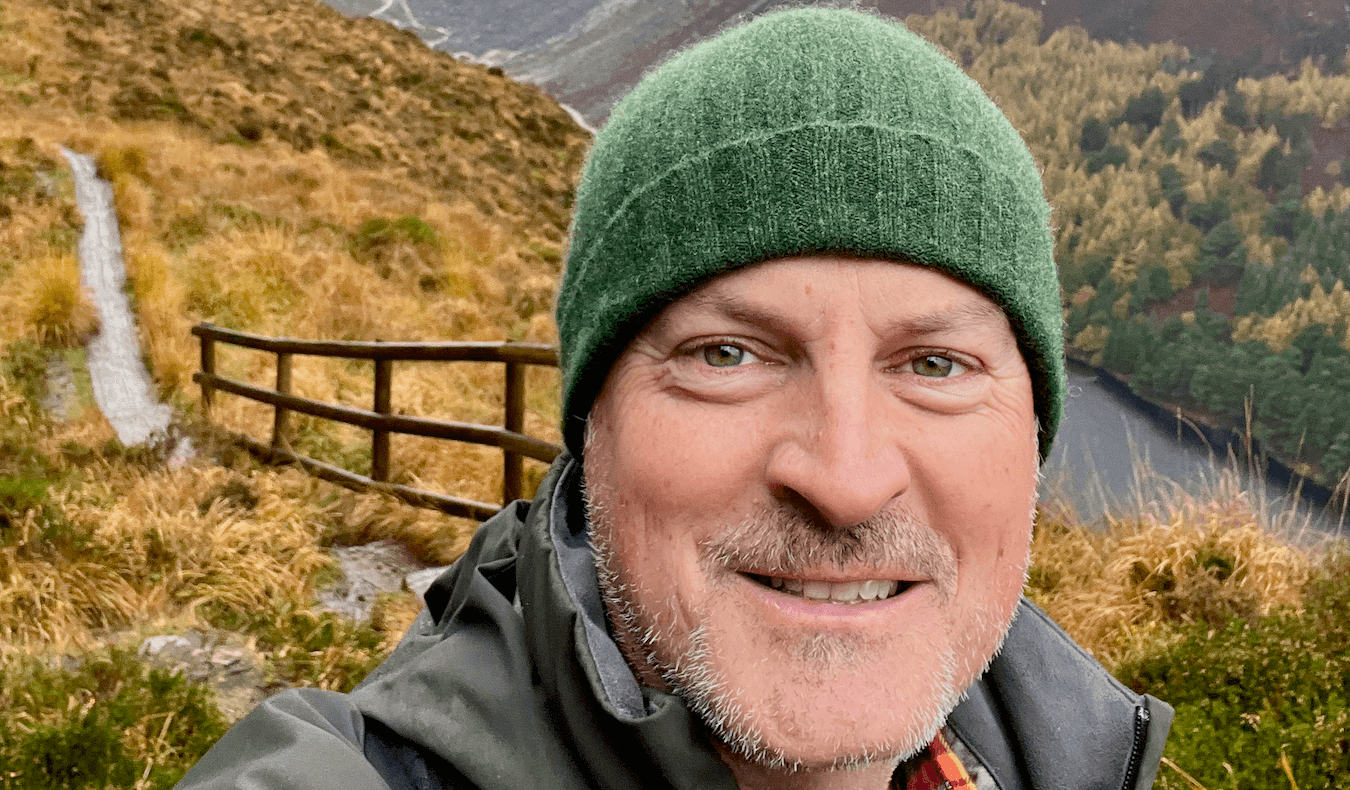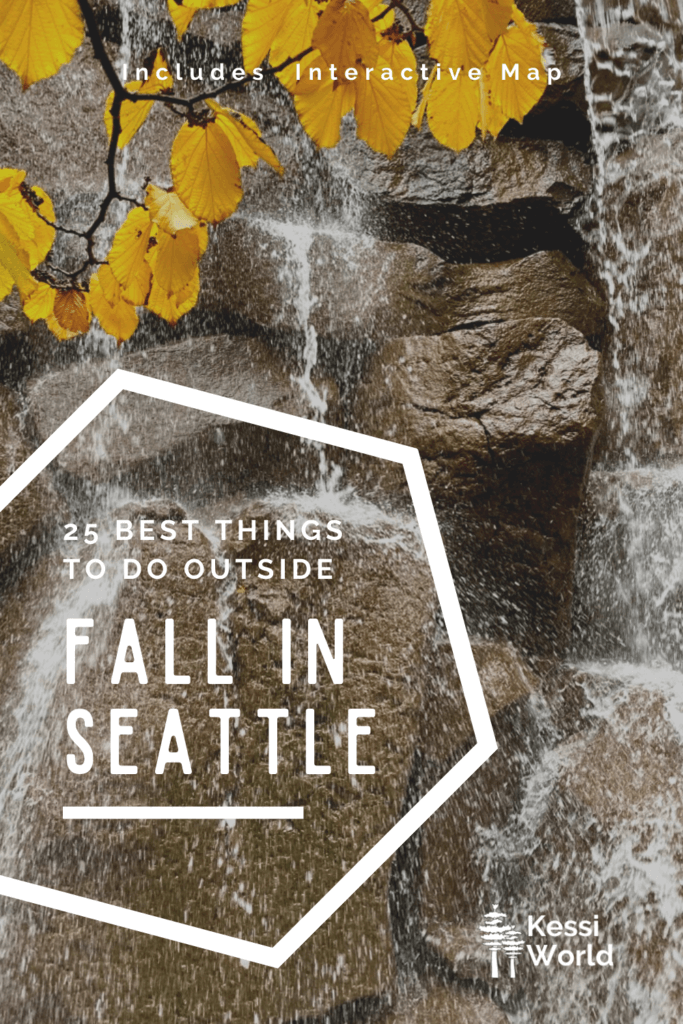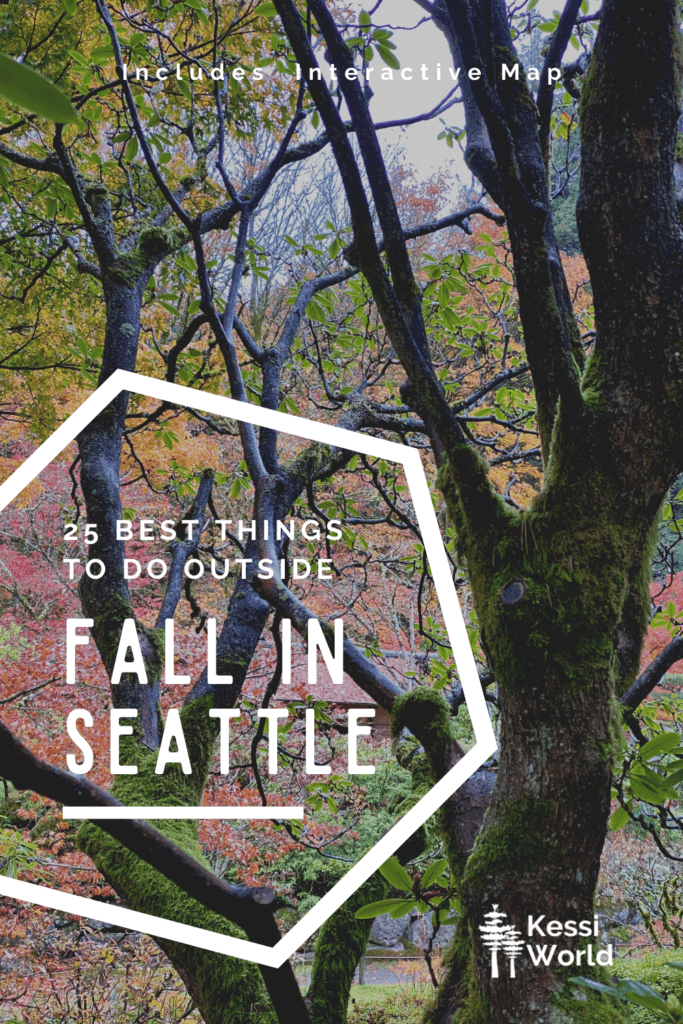How to enjoy Fall in Seattle — 30 of the best outdoor things to do.
How to enjoy Fall in Seattle: A local’s 30 outdoor things to do. Salmon jumping, Leaf-peeping, urban hiking, mindfulness meditation, nature immersion, and more. With map & videos.
Read more for Leaf-peeping, jumping salmon, brilliant colors, joyful flowers, cleansing rain, forest bathing, installment art, urban walks, mindfulness meditation, and setting emotions adrift in local waters. Also known as, a fantastic Fall in Seattle. Includes map and videos.
Fall in Seattle is my favorite time of year. The weather holds out well into October. Crisp, cool mornings open to optimistic afternoon sunshine, and the mosaic of colors transitions like a kaleidoscope from September Dahlias to November storms swirling yellows of big-leaf maple. Kids are back in school, and visitors are slowing down after a busy summer of cruisers.
Learn how to experience the unique splendors of Fall in Seattle. You’ll find 30 tested ideas from a local mystic — proven to engage your senses.
As a practical mystic, I focus on activities and locations that inspire a deeper connection — to myself, my loved ones, and to this soulful land.
What is a practical mystic? Let’s say that I use my “natural intuition” to merge Nature’s Intelligence with my inner self (also known as my own nature) in ways that foster belonging, resilience, and purpose.
I can help you do this, too. It’s my superpower.
You can create your own way to change how you see yourself in nature.
Embracing Nature’s Intelligence begins with the understanding that you are part of nature, not just a visitor passing through. At any given moment, in any location, you have a stake in the land. When you embrace this, everything changes.
You’ve likely already had an experience with Nature’s Intelligence, such as the wonder of a technicolor sunset or witnessing the migration of jumping salmon intent on returning to their ancestral spawning grounds by smelling the familiar waters flowing to the Salish Sea.
But these moments don’t have to be accidental or fleeting. They don’t require driving to a remote part of Washington State. This isn’t just about nature meditation or forest bathing. You can create your own way to immerse yourself in the beauty of Fall in Seattle or anywhere else.
The difference between a mediocre and remarkable experience is entirely within your control. But ideas help stir the senses and open up creativity—and I have ideas!
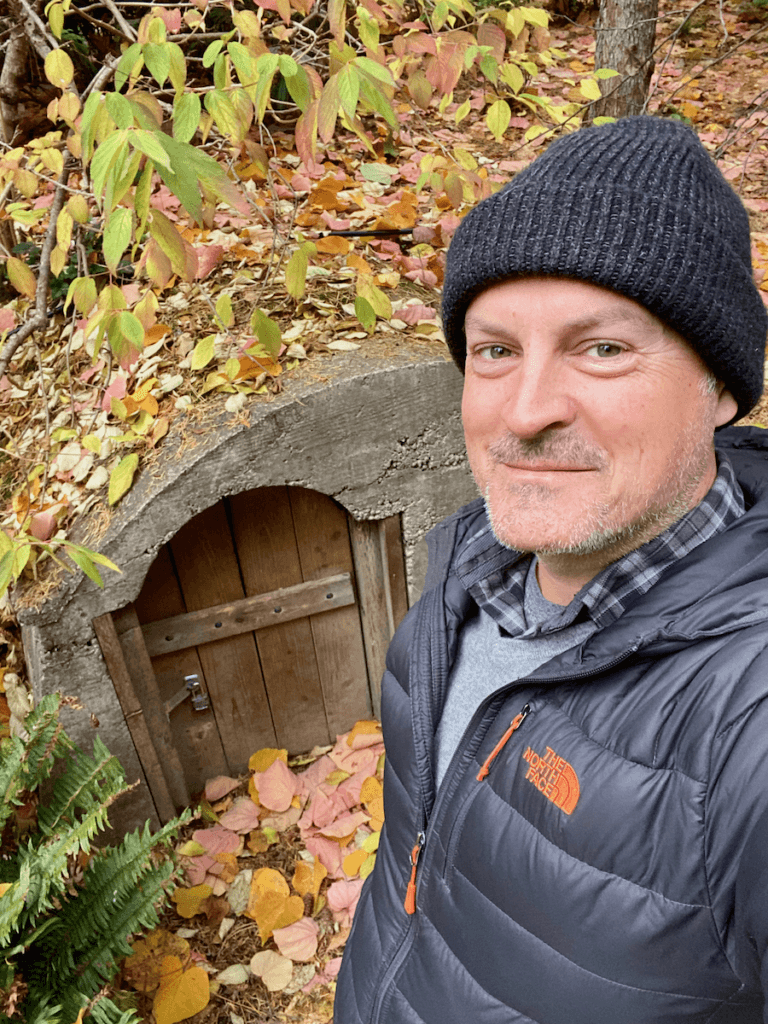
This article shows you where and how to engage the magic of Fall in Seattle.
Connect your inner self with Nature’s Intelligence—with 30 outdoor things to do. Best for:
- New to Seattle.
If you’re new to the Emerald City, and looking for excellent ways to make a nature connection, keep reading. - Hosting out of town visitors.
It can feel tedious to take your guests to the same touristy spots over and over. Breathe some fresh air into your itinerary. - Re-vision your relationship to home.
As a Seattle local you might’ve experienced some of these ideas. But this is an opportunity to re-engage with the Pacific Northwest in new ways. - A season for healing, wellness, or awakening.
Fall can symbolize letting go, and this framework can help you with the where and how.
Table of Contents & Abundant Ideas
Why should you listen to a mystic like me?
How to deepen your nature connection
Fall in Seattle and then onward to National Parks, Vancouver, BC or Portland?
The short list — Five unique Fall in Seattle outdoor things to do
- Watch the salmon jump!
- Ride a ferry
- Forest Bathing in the rain
- The best Seattle parks for fall
- Visit Mt. Rainier
The best of all worlds — a nature meditation retreat on the Olympic Peninsula
The best parks to enjoy Fall in Seattle
- Explore a Japanese-inspired garden
- Wander among the flowers (botanical gardens)
- Play in the giant’s world — find an ancient fir forest
- Get garden envy at a neighborhood P-Patch
- Play on the Peninsula — Bloedel Reserve and Heronswood Garden
Urban hiking — Fall in Seattle exploration
- Capitol Hill Urban Walk
- Ballard maritime diversity
- South Park
- University of Washington
- Columbia City
Expressive art — Outdoor Fall in Seattle Things to do
- Art of Seattle University
- Olympic Sculpture Park
- International Fountain and Art of Seattle Center
- Chinatown and UPS Waterfall Park
- Amazon Spheres and “Tron City”
Seattle waters nourish the soul any time of year
- Elliott Bay Trail
- Alki Beach — West Seattle things to do in Fall
- Ballard Locks
- Fisherman’s Terminal
- Take a float — boating options.
Leaf peeping adventures — Fall in Seattle colorful drives
- Federal Way parks and gardens
- Point Defiance Park — Tacoma
- Bainbridge Island and Kitsap Peninsula
- Skagit Valley harvest season
- Nisqually Wildlife Refuge
Interactive Map
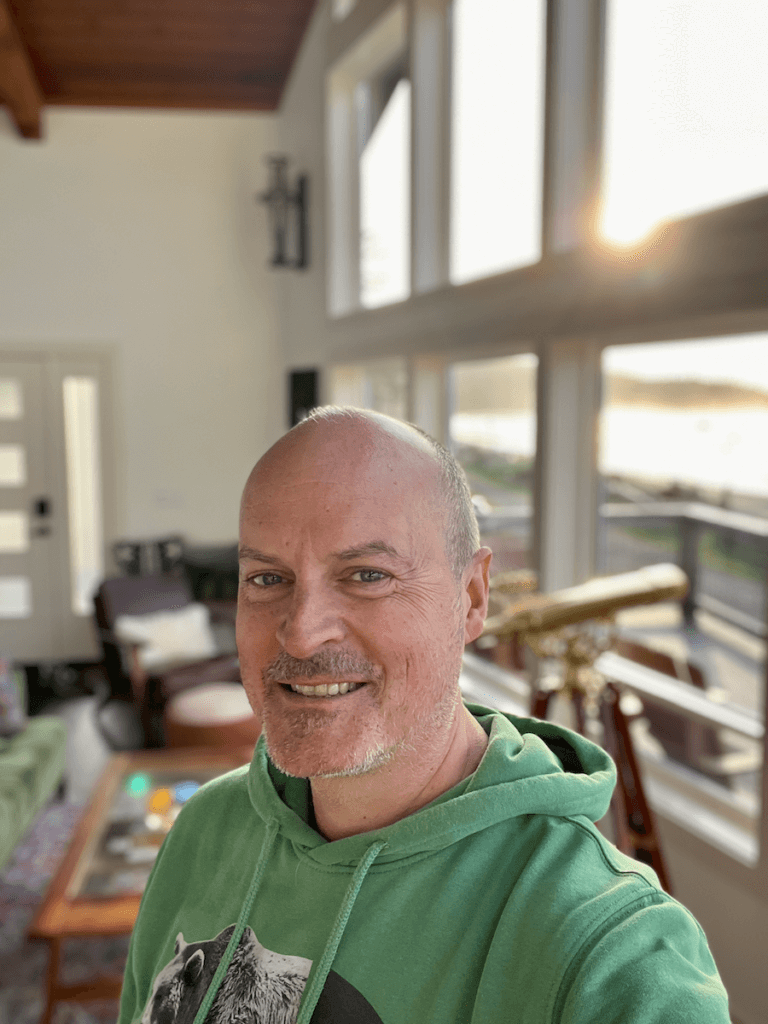
Why should you listen to Matthew Kessi (that’s me)?
- The Pacific Northwest is my lifelong playground.
- As a former travel industry professional, my experience guiding people around Seattle and Washington State gives me valuable insight into the right balance between what is possible and rewarding.
- Unlike big travel websites, I’ve been to all the places, tested the ideas, eaten the food, and taken photos. Unless specified, I don’t receive compensation for naming specific locations — my recommendations come from the heart.
- Since I live in Seattle, well… I’m around to frequently keep my knowledge updated.
- I’m a practical mystic, which means I actively integrate spiritual sensitivities and meaningful applications in daily life. I can help you find more rewarding experiences grounded in nature — and you can be more present to yourself, your companions, and all the wonders of travel. In another article, “Six steps to deepen your nature connection, “ I write about the fundamentals to do this.
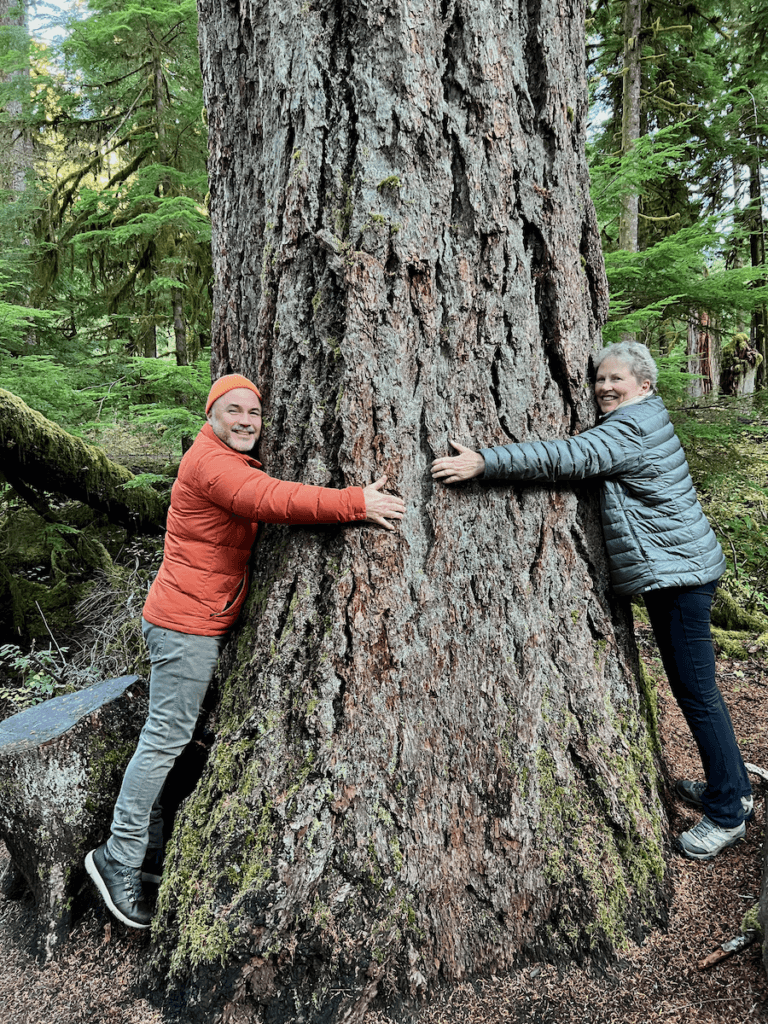
Three-day Olympic Peninsula nature meditation retreat.
In spring and fall, I facilitate mystic nature meditation retreats on the doorstep to Olympic National Park — in a wild area of Washington State, about three hours from Seattle.
This is a one-of-a-kind experience that will transform the way you see yourself in nature. When you pause daily life in order to see what impedes, supports, and transforms you, the resulting healing, wellness, and awakening may surprise you. Superb lodging, food, and mystic-guided experiences await.
What is the difference between mediocre and remarkable experiences in the outdoors? Connection with Nature’s intelligence.
The difference between a “meh” experience and a memorable one is about grounding with the natural environment. You can probably think back to wonderful memories, and the common denominator would be feelings of belonging—or connection—to yourself, your companions, and the destination.
Whether that is childlike joy of droplets falling on your forehead from a cedar bough or sighting a rare bird on nearby log, magic occurs when you’re open to the beauty of a connection. The wonder awakens your inner self—or your true Nature.
Often, the loudness of modern culture, especially in a big city like Seattle, adds static—especially in ways that might make you feel anxious or rushed. Unrealistic expectations prevent a total opening up to the possibilities, consciously or subconsciously. That’s why—without grounding—you might return home unphased by the experience.
Allowing yourself to focus on grounding in Nature’s intelligence will monumentally change the way you embrace the joy of fall in Seattle. But don’t worry. You can still enjoy your favorite experiences, like riding a ferry, gazing at breathtaking views, or running your fingers along the bark of an ancient fir. Consciously deepening your connection to Nature makes all these things more meaningful because you’re more connected to your heart and soul—or your true Nature.
Over my lifetime, I’ve developed a series of questions that are guaranteed to help anyone practice focusing on a more profound connection with Nature. This simple and accessible framework is proven to work — with remarkable outcomes. Staying grounded and mindful takes as little as 20 minutes daily. I give you all the information in my article, Six questions to ask yourself to deepen your nature connection.
This entire article and all my recommendations use this foundation to encourage you to take your grounding in Nature seriously while enjoying the wonders of Fall in Seattle.
You will enjoy the best possible experience when you slow down to a natural pace and see youself as part of Nature, rather than a spectator.
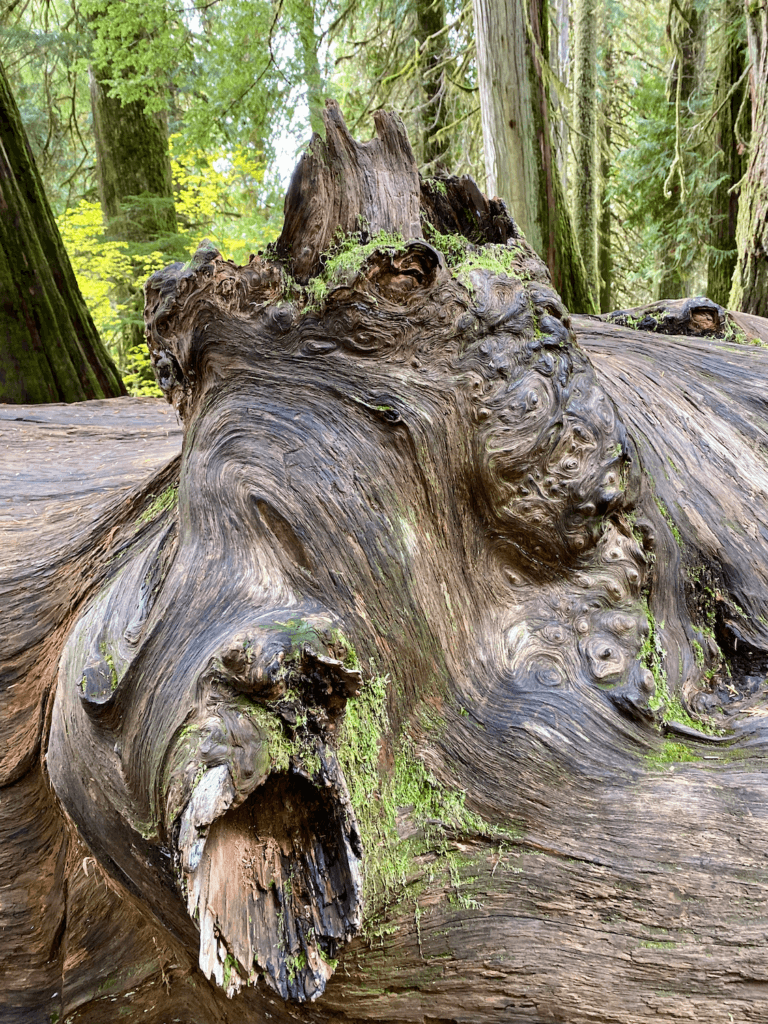
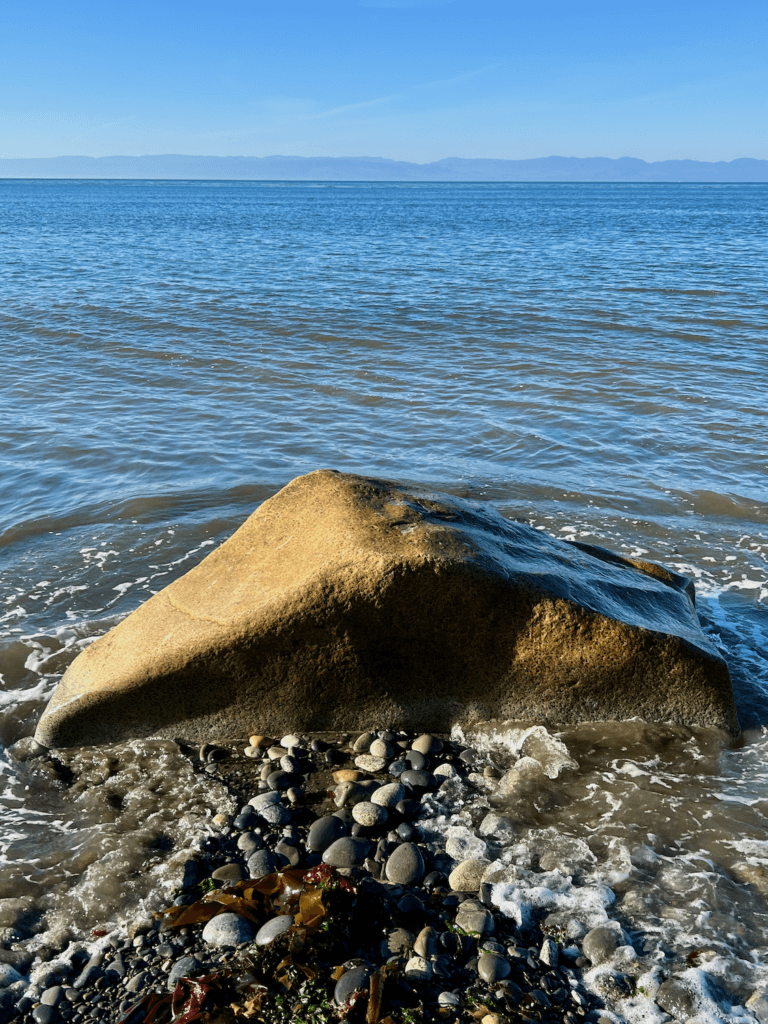
Fall in Seattle plus National Parks, Portland, or Vancouver, BC?
As a lifelong Oregon & Washington State local and former travel industry professional, I know how to get around the Pacific Northwest. I wrote an article about how to get to Portland from Seattle (and vice versa) and an even more specific post about the train between Seattle and Portland. I also offer an excellent itinerary for the Seattle to Portland drive.
You may be transiting to and from beautiful British Columbia in Canada. In this case, check out two articles about how to train from Seattle to Vancouver and the Seattle to Vancouver drive, which has my very comprehensive map of things to do; see, and eat between the two metro areas. The drive is particularly gorgeous in the fall — especially Chunanuk Drive between Bow, WA and Fairhaven, Bellingham, WA.
Seattle is also a great jumping-off point for exploring the beautiful wilderness of Washington State’s three National Parks. While Mt. Rainier National Park, and epecially Paradise are stunning in the fall season, they require a bit of weather research from mid-October onward. Another epic mountain experience (again, check road conditions) is outlined in Seattle to North Cascades National Park.
But Olympic National Park is available all fall. Access my article, How to Plan an Epic Olympic Peninsula road trip, for all the details.

Do you need help planning an epic Seattle and Pacific Northwest trip?
Whether it’s your first time to Washington State, or you plan to host out-of-towners, I can help you craft an ideal itinerary for your needs. We meet via Zoom for an hour and you’ll:
- Leave the call with a clear plan.
- We can map out two itinerary options.
- Two follow-up email correspondences.
Click HERE for more information or SEND ME AN EMAIL.
Fall in Seattle greatest hits. My top five recommendations.
I’m an Airbnb Superhost in Seattle, having hosted thousands of guests over the last ten years. As you might imagine, many of my visitors request help with planning outdoor experiences — especially during Fall in Seattle, when the perception of bad weather weighs into the psyche.
It’s difficult to go wrong enjoying Fall in Seattle, because no matter where you look nature abounds. But when my Airbnb guests ask me for suggestions, these are my top five loves about the Emerald City in this season. If you only did these things on a visit, or while hosting friends and family, it would cover the bases very well.
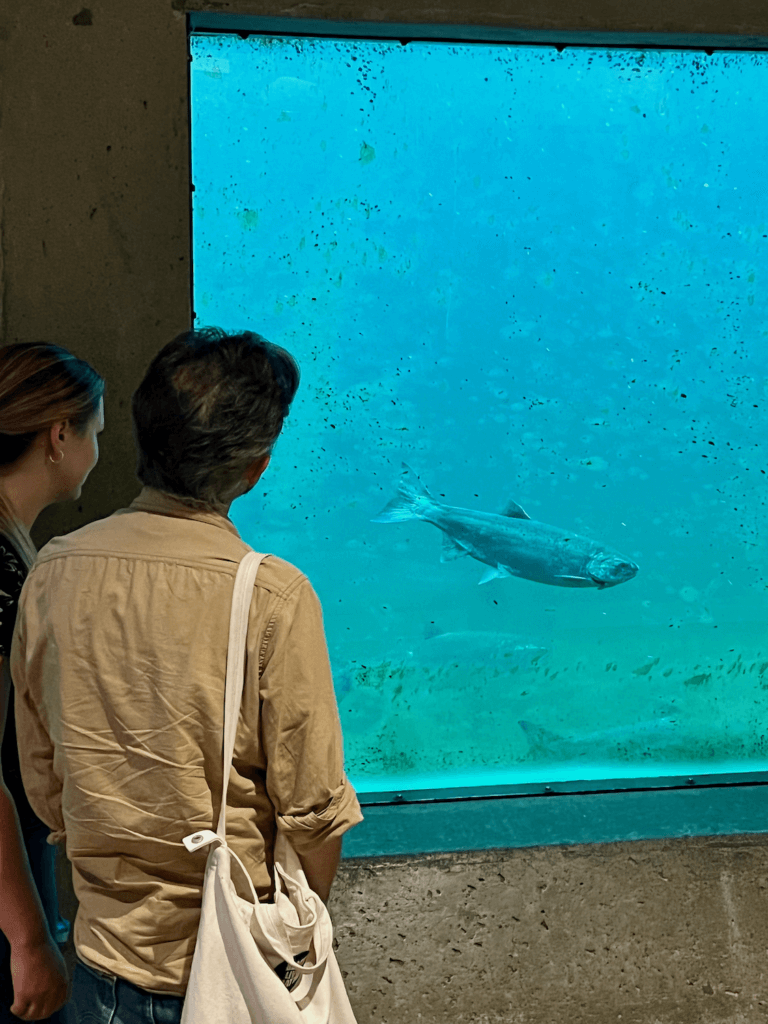
Watch Nature’s Intelligence in salmon jumping action.
If ever there were a way to witness Nature’s Intelligence in Fall in Seattle, this is it! These unique species of fish engage in an ancestral call to return to the same rivers and sandy creeks to spawn each fall.
These are five favorite places to set up shop to learn and watch. Depending on the species of salmon (there are many) and location, you can experience salmon migration into November, somewhere.
Take this opportunity to slow down, quiet the mind, and spend some time immersed in Nature’s miracles.
- Ballard Locks (Central Seattle)
- Carkeek Park (North Seattle)
- Issaquah Salmon Hatchery
- Kanaskat-Palmer State Park
- Salmon Viewing locations across Washington State.
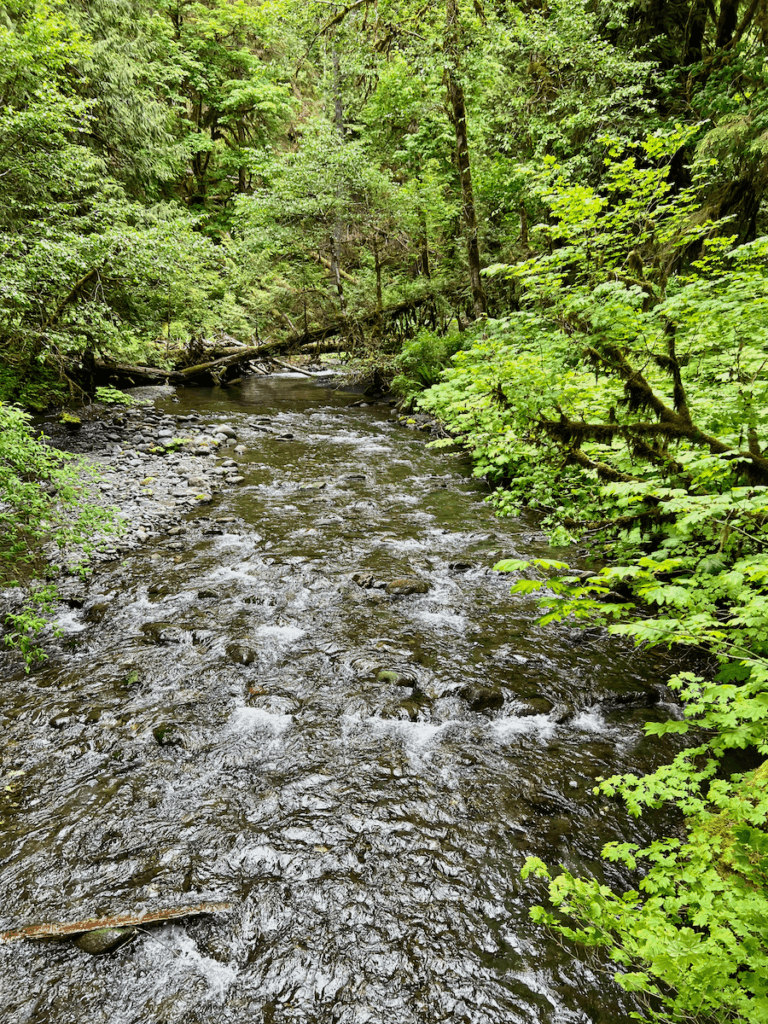
Sol Duc River — Olympic National Park
It’s hard to beat the amazement of watching salmon navigate this magical river, just inside Olympic National Park. Best times to spot the jumpers is mid-September through mid-October. It takes about 3.5 hours to get there from Seattle, including a beautiful ferry ride. For more information on planning a visit, check out my article, How to plan an Olympic Peninsula road trip.
Take the Washington State Ferry
Nothing beats floating through the Salish Sea on a ferry. No matter the weather, walk onto a trusty workhorse at Coleman Dock in Downtown Seattle. At the time of this update (Fall 2024), the passage costs $9.85 per person for the round trip. Machines sell tickets, or ORCA (Seattle Transit) cards are accepted — right as you walk through the boarding gate. Since the fare is only sold as a round-trip, no tickets are taken when boarding the eastbound return to Seattle. Be sure to spend some time on the deck, looking for kelp beds and the elusive Orca whales.
The view of the skyline of Seattle is impressive as the boat pulls away from the city, and an hour later, you’ll feel the bump of the ferry into the Bremerton pilings. If you’re interested in Bainbridge Island, check out the other mentions in this article. Bremerton makes for a fun boat trip with the same allure and views, but the destination feels more local.
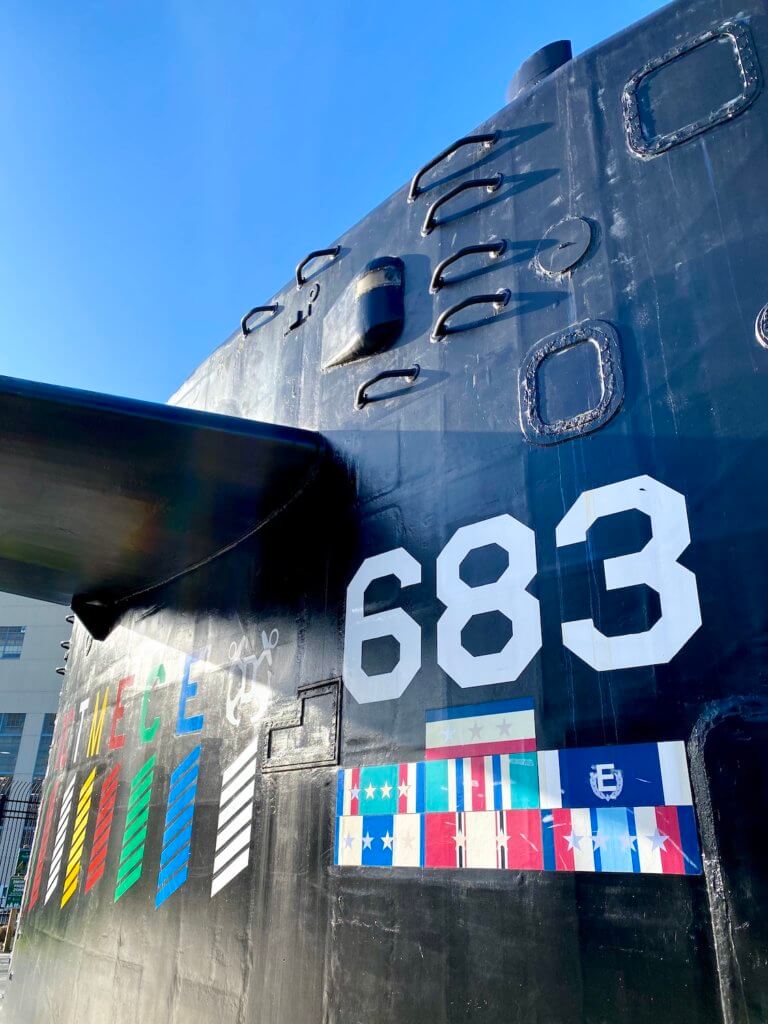
Is Bremerton walkable?
Yes! The ferrry terminal is snug between the massive Naval Shipyard and the downtown core. There are several great musuems to peruse, as well as shops and street art. For more information on a day trip to Bremerton, check out my article, Bremerton day trip from Seattle.

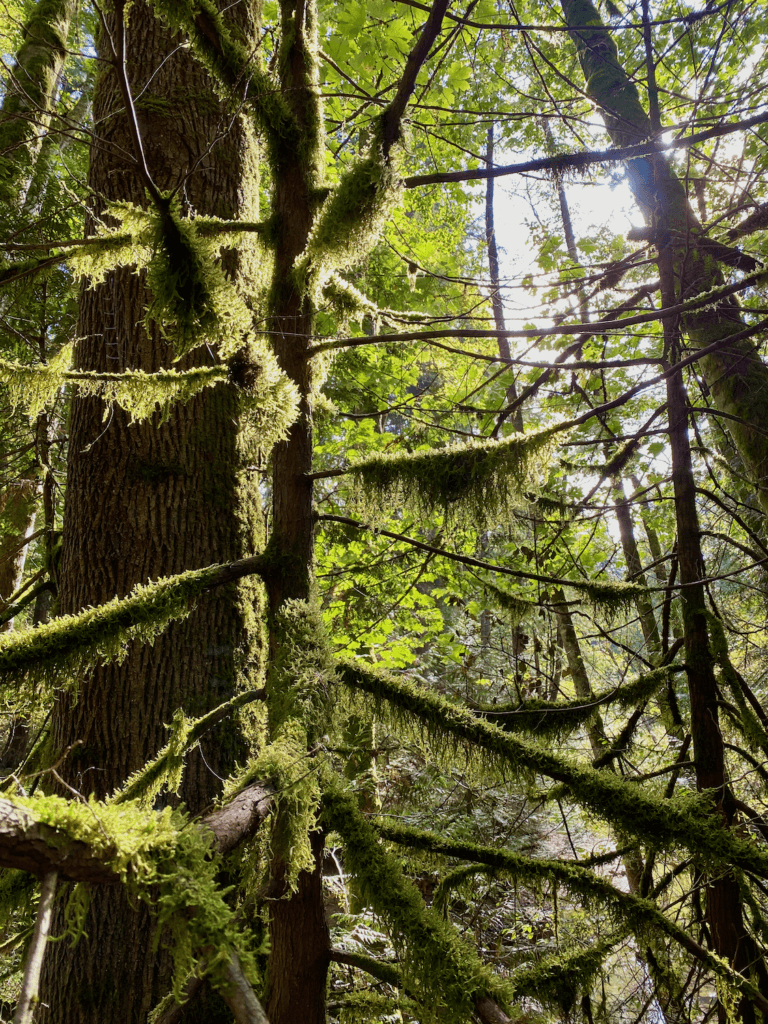
Forest Bathing in the Rain — a famous outdoor thing to do
Shinrun-Yoku, the Japanese term for Forest Bathing, was developed in the 1980’s to combat sickness workers experienced in the giant migration from rural areas to cities in Japan. The studies were actually conducted by corporations that wanted a healthy and productive workforce. And daily doses of nature immersion did the trick.
A growing body of research points to the beneficial effects of exposure to the natural world on health, reducing stress, and promoting healing. Some studies further clarify that only 20 minutes daily (of immersive natural experiences) are essential to producing lasting benefits such as lower blood pressure, higher concentration, improved mental health, and neutralizing inflammation.
My version of Forest Bathing is accessed through a framework of Six Questions to Ask Yourself for a Deeper Nature Connection. Regardless of your approach, a rainy fall day in Seattle (or even overcast) offers an exquisite opportunity to engage your Nature in powerful ways that might just surprise you. For my favorite locations, check out, Forest Bathing in the Seattle rain.
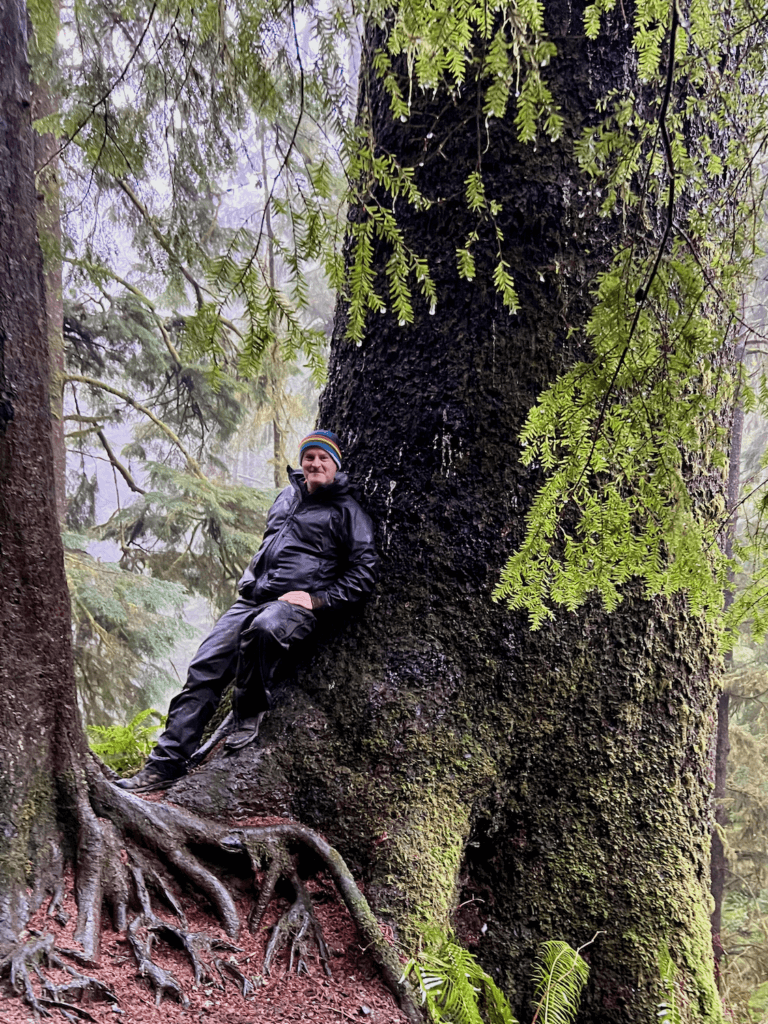
Layer up! And… no umbrellas.
Although Seattle’s weather is usually pretty great in September, the precipitation can begin to fall in earnest by the end of October. It’s best to be well equipped with warm layers and a waterproof, not water-resisitant, outer shell. You’ll also thank youself for wearing waterproof footwear.
On umbrellas, it’s not that we’re snooty about their use. It’s just not practical to dedicate a hand to holding something while navigating nature’s moist wonders.
Just Park It! My top picks to enjoy Seattle in Fall
There are so many great park and garden options to enjoy fall in Seattle. You’ll find an entire section of ideas further down this article. But if you can’t wait and want my favorites for each area of town, here goes.
- Volunteer Park (Central Seattle)
- Washington Park Arboretum (Central Seattle)
- Ravenna Park (UW District)
- Carkeek Park (North Seattle)
- Bellevue Botanical Garden (Eastside)
- Kubota Garden (South Seattle)
- Lincoln Park (West Seattle)

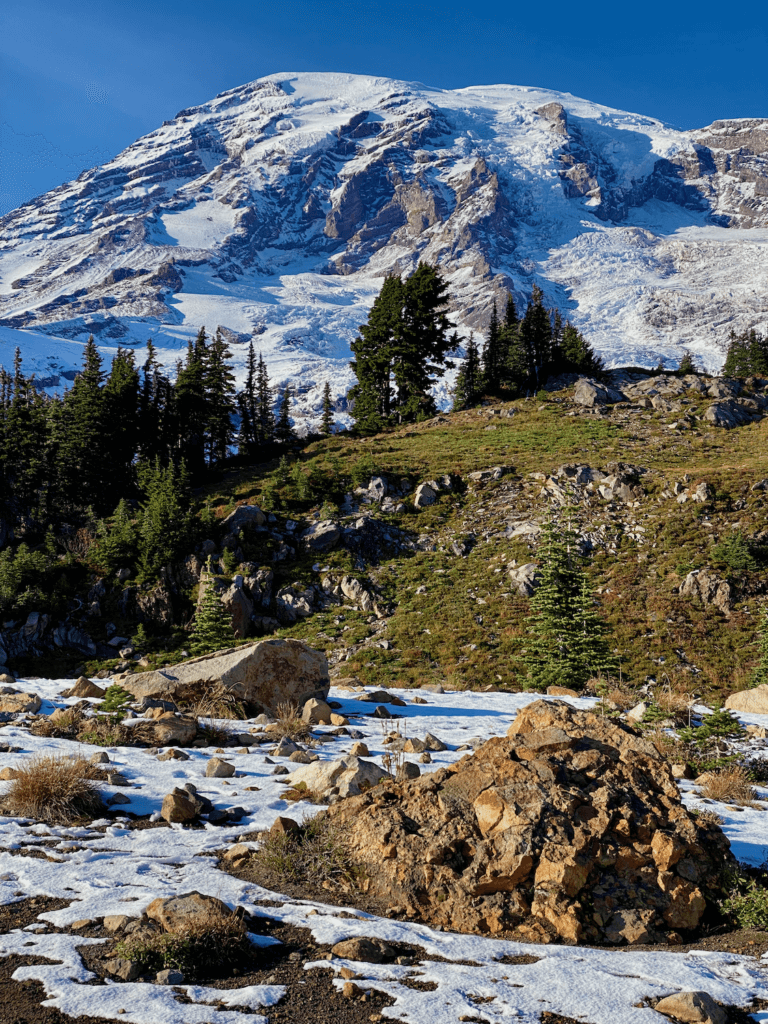
Visit Mt. Rainier
Ascending to 14,410 feet above sea level, Mount Rainier stands as an icon in the Washington landscape. An active volcano, it is the most glaciated peak in the contiguous U.S.A. and spawns five major rivers. Subalpine wildflower meadows ring the icy volcano, while ancient forest cloaks Mount Rainier’s lower slopes. Wildlife abounds in the park’s ecosystems. A lifetime of discovery awaits. –National Park Service
While most of the services on “the Mountain” as locals call her, close for the season around mid-September, I love to visit this bastion of wonder in October. The fall season hems together stunning hues of red, yellow, and orange with light dustings of snow (like the photo shown). There are trails to explore at all altitudes, but be sure to check road conditions. You’ll compete for parking with way fewer visitors, espeically mid-week.
I provide a comprehensive guide on how to plan an amazing day-trip from Seattle to Mt. Rainier, as well as more specific information for Paradise, which is a true love of mine. Try to go in the morning or a few hours before sunset.
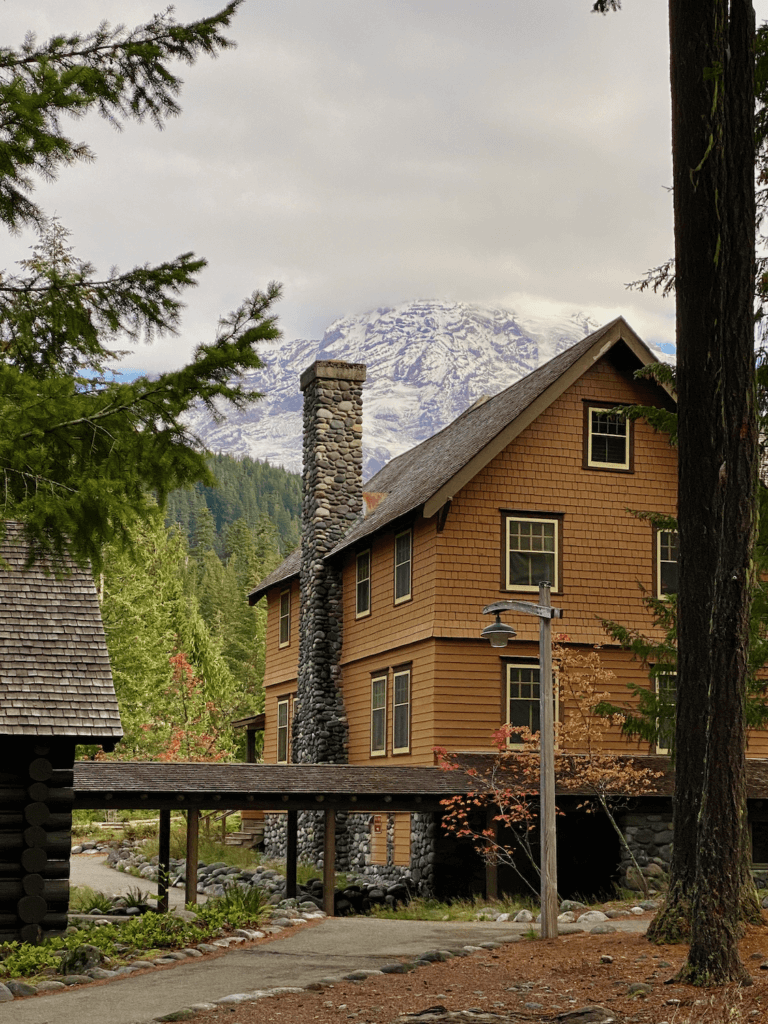
Consider a longer stay on Mt. Rainier?
Paradise Inn closes by the end of September, but if you can sneak in I highly recommend it. Gaze at the stars by night and wake up to pristine alpine air in the morning. But if you visit later in the fall, consider National Park Inn, which is just inside the park from the Nisqually Entrance. There are also numerous options in nearby Ashford, WA. This is a great Airbnb to try.
Learn what impedes, supports, and transforms you through Nature Meditation.
Are you stuck in the hamster wheel of daily life, yearning for change but unsure where to start? Are life circumstances overwhelming you, leaving you feeling lost and anxious? Is there a background static of uncertainty holding you back? Welcome to a transformative nature immersion retreat and guided mindfulness experience that will empower you to see your wild nature. You will forever be changed.

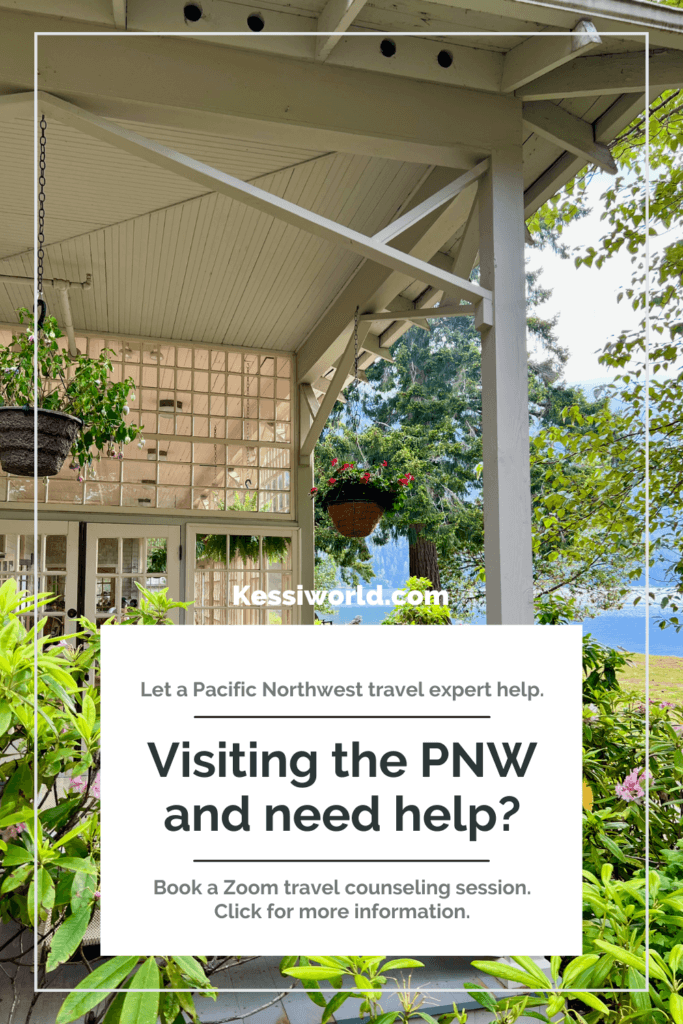
Travel the Pacific Northwest with purpose and meaning.
A lifetime of wandering about Oregon and Washington State gives me powerful practical wisdom to share about travel. And you receive the bonus of my unique mystic connection to the land. I can show you how and where to deepen in nature. This is perfect for:
- First time visitors to the Pacific Northwest.
- Locals hosting out-of-town visitors.
- Those wanting to experience travel + nature + spirit in new ways.
The best parks to enjoy Fall in Seattle.
Seattle area parks exhibit the inspiring beauty of Pacific Northwest nature in unique ways each season — but can be particularly inspiring in fall. In other articles, I write about the Best Botanical Gardens, P-Patches (community gardens), and Places to View the Seattle Skyline, which highlight a number of my favorite parks.
The autumn breeze flows in time with the changing colors — first late-season flowers, then blushing bushes, followed by magically golden trees. The experience is about the elements coming together to showcase Mother Nature’s version of letting go right on time. If you’re interested in my how-to guide to diving deeper into connection with nature, check out my article Seattle Autumn — 5 inspiring walks to elevate your nature connection. The following collection is my list of favorites to enjoy the transformative time of Fall in Seattle.
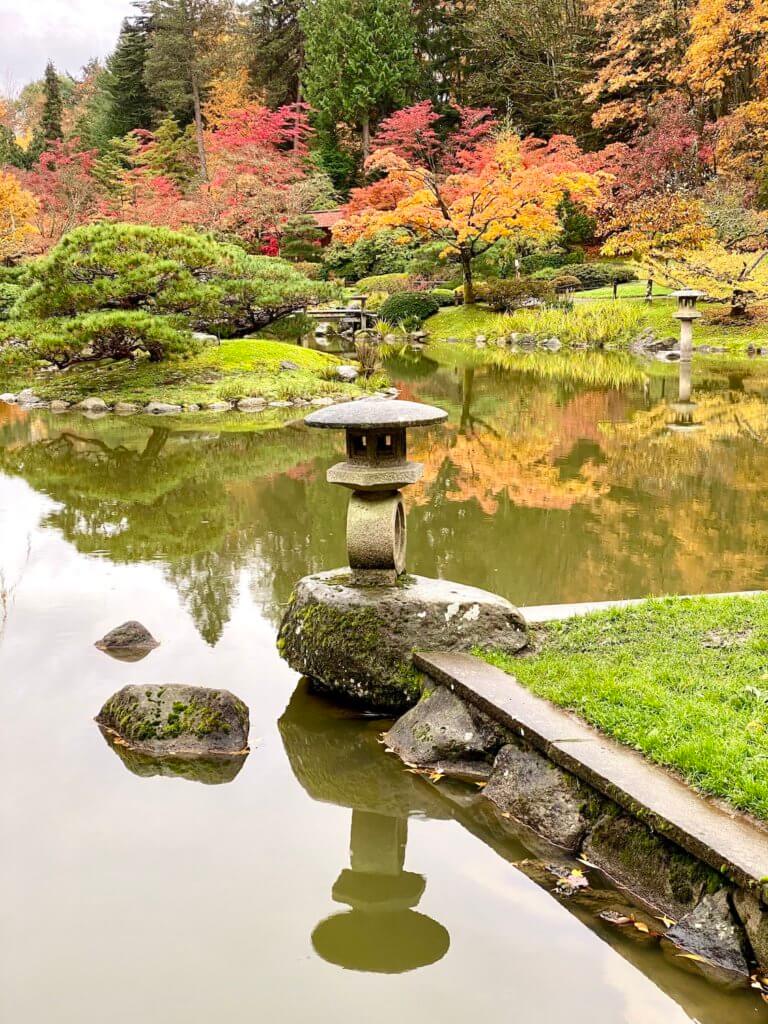
Explore a Japanese-inspired garden
Ah… my heart opens the moment the topic turns to Japanese-inspired gardens in Seattle, especially in fall, when the layers of texture start to draw contrasting lines. Imagine crimson-red leaves pushing through twisted branches of laceleaf maples while a tranquil brook bubbles over strategically placed rocks designed to welcome tranquility. Bamboo shoots hold a commanding presence despite the deep green moss, and proud pagodas provide vantage points to survey the landscape.
Japan and the Pacific Northwest have enjoyed solid ties for over a hundred years. While the official Seattle Japanese Garden in the Washington Park Arboretum is stunning, many other examples of inspiring fusion between traditional Japanese style and Pacific Northwest botany exist. My article, The most inspiring Japanese gardens in Seattle can provide you with more helpful information.
Frolic outside in the fall colors of a favorite botanical garden
The Bellevue Botanical Garden is a fantastic experience any time of year. I love the dahlia garden, with abundant varieties of fiery reds, purples, and pinks flowing as if lighting the way to the shade gardens. Wander among the gravel paths and ascend the strategically placed stone slabs to the original mid-century style residence of Cal and Harriet Shorts. They generously deeded the land to start this garden in 1981.
The flower beds seem to magically shift into the brilliance of each moment of every season, making this space one of the most inspiring in the entire Seattle area — especially for the price (free). This is one great example of the plethora of botanical gardens available — many with free entry — to explore in the transitioning season of Fall in Seattle. I’ve written numerous pieces on this subject, and for a more compressive list of favorites, check out my article about the Best botanical gardens in Seattle.

The ahhhs of Dahlias
Dahlia gardens provide an oomph of fall color — especially in the September sunshine. In particular, I love the scene at Volunteer Park, across the lawn from the Conservatory. See how many varieties you can count. Point Defiance Park in Tacoma also has an inspiring showing.


Play in a giant’s world — find an ancient fir forest
Not every old-growth fir tree has been razed from the land over the past hundred years. There are remarkable remnants of the ancient wonders in several places around Seattle — welcoming despite the mysterious mist sometimes found in fall.
Check out the sprawling hill above Azalea Way in the Washington Arboretum — full of unique redwood, cedar, and fir varieties. Although they are not old-growth, they’ve been providing shade to the world for a hundred years.
Alternately, head to West Seattle and follow the creek through Schmitz Preserve Park — filled with age-old cedar and Douglas fir and teenagers expressing their independent streaks. Even busy Seward Park has a beautiful secret deep within the running trails no one visits — which feels like entering another world. Ravenna Park and several more green spaces can offer this magic — so run for the forests! And be sure to hug a tree.
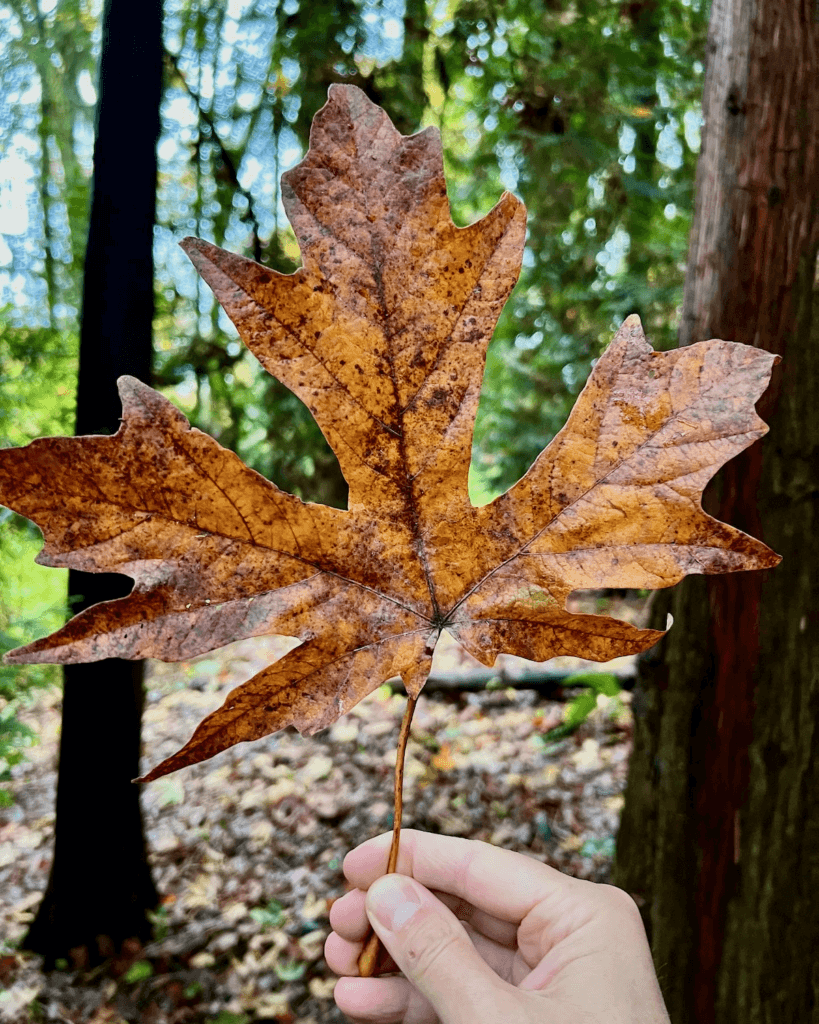
Federated Forest
This majestic forest full of ancient fir trees unassumingly hugs the side of a busy road whisking people to and from Crystal Mountain ski area and Mt. Rainier. It could be a bad ski day. But stop on the way home and soak up the spirit. Or, plan this as the destination.
Get garden envy this Fall at a local Seattle P-Patch
One of the first things I noticed when I moved to Seattle during the harvest season was the variety of public gardens right on the street for the world to enjoy. Community members assemble to lovingly cultivate flowers and produce — the colors stay inspiring and bright well past September.
While the reward begins to diminish later in October, along with the weather, I still find these organic spaces inspiring and peaceful any time of year. I love this concept so much that I created a photo essay titled, Seattle P-Patch photos — community gift of color In unexpected corners. For more information and the locations, check out the Seattle P-Patch website.
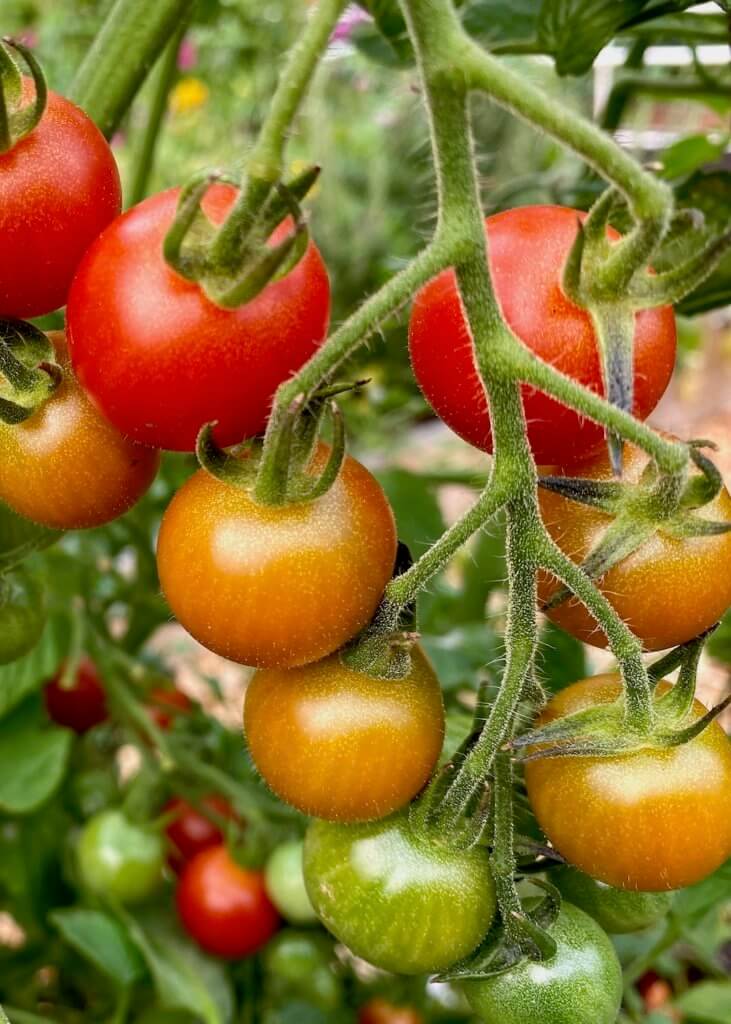
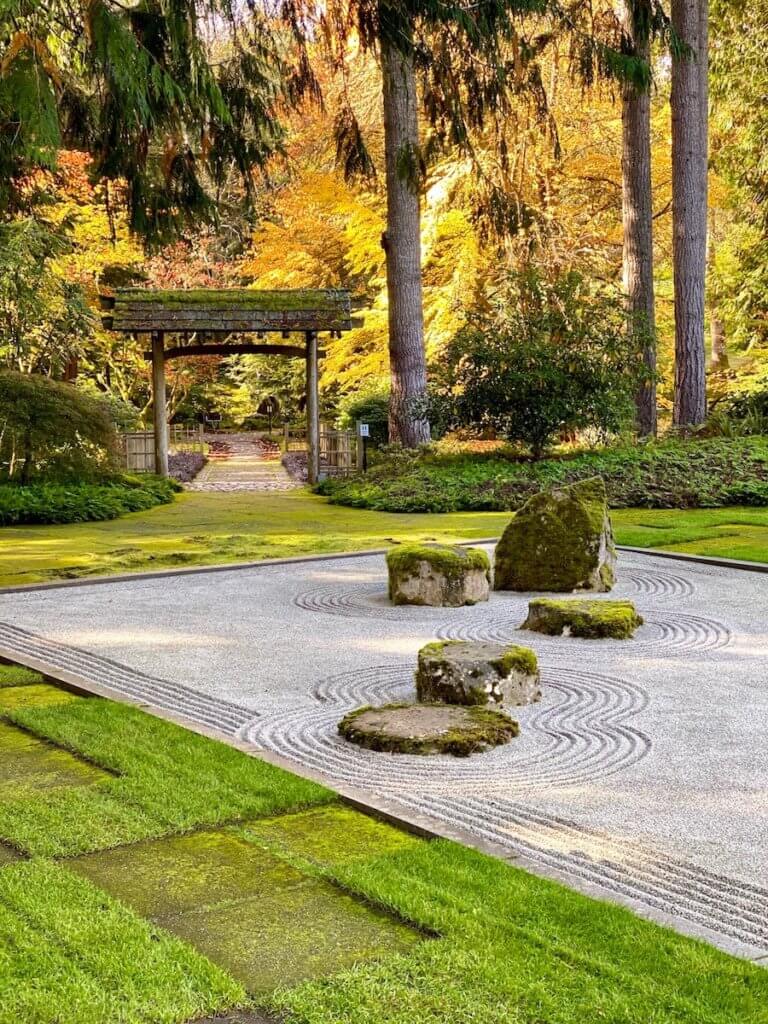
Play on the (Kitsap) Peninsula — Bloedel Reserve and Heronswood Garden
Although not in Seattle proper, two extraordinary gardens in Kitsap County are worth a trip across the Salish Sea in the fall. Bloedel Reserve (Bainbridge Island) and Heronswood Garden (Kitsap Peninsula near Kingston Ferry) provide surprise and delight around every bend.
I’ve written about Bloedel Reserve in a photo essay highlighting fall colors’ beauty. The internationally-awarded grounds are expansive with several zones: meadow, wetlands, forest, formal residence gardens, Japanese garden, and the luscious moss garden. The Japanese teahouse inspired by the native longhouses of the Coast Salish Tribes is exquisitely unique — surrounded by the most precisely raked gravel zen garden. It is not to be missed!
Timed-entry tickets are required. Adult tickets are $22, and I suggest securing entry first thing in the day, at 10:00 AM (Tuesday through Sunday), and then following up this experience with a short 10-mile drive through beautiful fall foliage to Heronswood Garden. This 15-acre space is owned by the Port Gamble S’Kllalam Tribe, who have infused rich life into the organic oasis. Enjoy the three distinct zones: a fern garden, a northwest garden, and a formal English Garden.
This trip is a great day jaunt from the Seattle area and serves up a drive through brilliant fall leaves. Follow my exact itinerary in the article, The best way to revive in a Salish Sea day trip — Bainbridge Island and the Kitsap Peninsula. Watch the video below:
Urban hiking — the outdoor allure of exploring Seattle’s diverse streets in the Fall
I’ve lived in Seattle since 2011 and love my experience in such a beautiful city with water, trees, and mountains in every direction. During the pandemic, I took to the streets and spent countless hours wandering the neighborhoods of Seattle — call it “urban hiking.” Fall in Seattle provides a perfect, albeit sometimes misty, opportunity to experience authentic neighborhoods bursting with many personalities. I look at these walks as excursions to be mindful while engaging in a nature meditation of a different kind. Especially while taking in the sights, smells, and sounds of a slightly new environment, there is more to discover in your own nature.
Link Light Rail opened up new stops north of Capitol Hill that provide more options to be creative and explore new areas within Seattle. Below you’ll find five of my favorite urban hikes that might not be on your radar.
The beauty of these suggestions lies in the tiny details like the homes proudly decorated, gardens lovingly cultivated and art masterfully displayed in unexpected areas. While you won’t find crowds, there just might be a connection to something new. Enjoy, and be sure to let me know what you think!
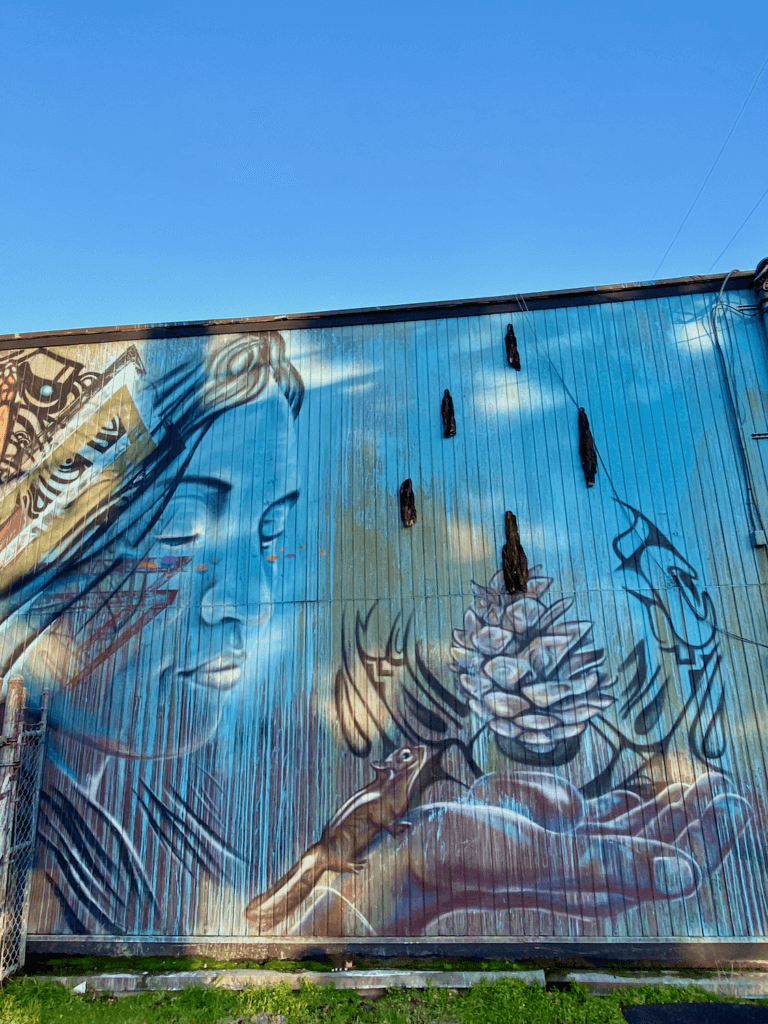
Mindfulness and the art of the CHOP — Seattle’s Capitol Hill — outdoor things to do in the Fall
I’ll begin this section with what makes an urban hike in my neighborhood — Capitol Hill — so fresh and vibrant. Visual stimulation is everywhere. Much of it consists of a mix of art — expressions associated with the Black Lives Matter protests that started in June 2020 after the murder of George Floyd.
I present a real-time account of the art in a photo essay written in June 2020 titled Art of Seattle CHOP. CHOP stands for Capitol Hill Occupied Protest and consisted of a small portioned area in the heart of Capitol Hill near the Seattle East Precinct Police Station. Today, you’ll find large letters spelling out “Black Lives Matter” on Pine Street between 11th & 12th Avenues.
Capitol Hill is central in the city and easy to reach by Link Light Rail. The tight commerce core between Pike/Pine offers quirky shops and the celebrated Elliott Bay Bookstore. I like Cafe Vita for coffee and Honey Hole Sandwiches, Bimbo Burritos and Oddfellows Lodge for food — but there are so many great restaurants in the area to try.
From this central business district, I suggest wandering up to 15th Avenue East and on to statuesque Volunteer Park, also featured in a more concise article about how to enjoy nature in Seattle during Autumn.
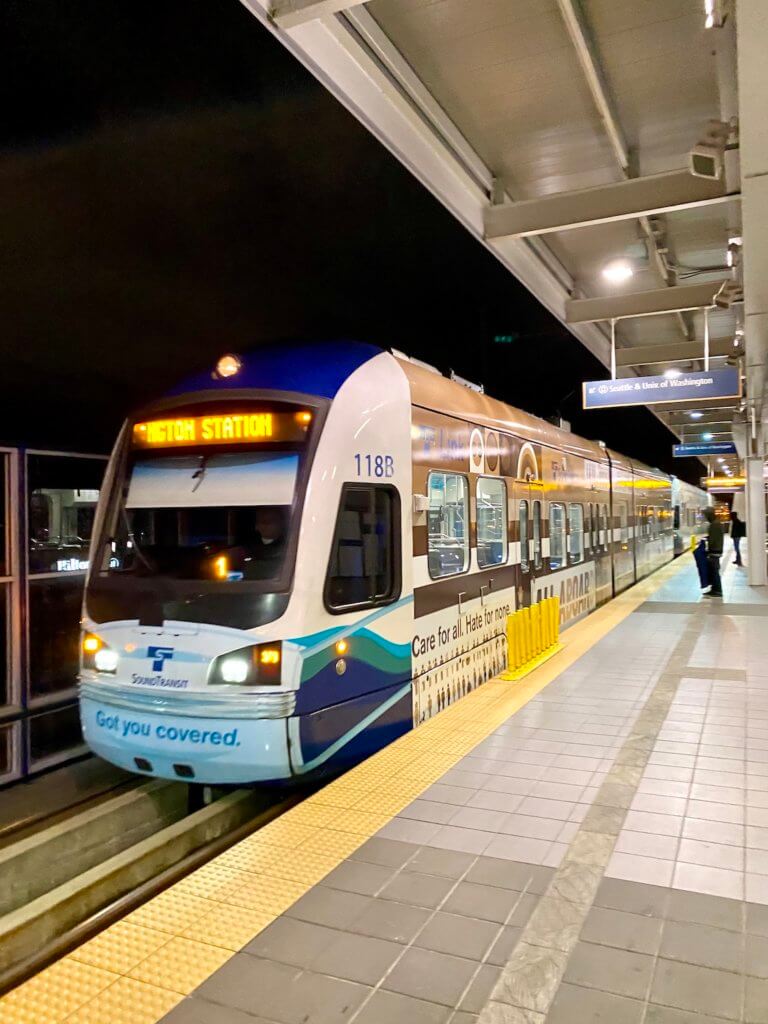
Getting to Capitol Hill
Capitol Hill has been popular with locals and visitors alike for over a hundred years because of the close proximity to Downtown Seattle. While there is a convenience Link Light Rail station in the heart of the action, it’s a brisk uphill walk about a mile from the hustle and bustle of Pike’s Place Market. Grab coffee at Starbucks Roastery and window shop along the way.
Ballard — urban hiking the diversity of maritime history in Seattle
Seattle is a maritime city, having grown up as a shipping center — first for timber export, then for prospectors heading to Alaska to seek fortunes of gold. Throughout this history, the rich bounty of fishing provided for many in the area, especially new immigrants from Scandinavian countries, who settled along the waterways in and around Ballard.
Today, the fishery industry still relies heavily on Salmon Bay (see Fisherman’s Terminal, below) as a freshwater port to operate and maintain large fleets of vessels dispatched to Alaska several times a year. But just a few blocks from the wharf areas, a different version of Ballard exists — one with delicious eateries, coffee shops, and key attractions.
For an energizing five-mile exploration, start at Ballard Coffee Works, right in the heart of the popular enclave, and work along NW Market Street toward the National Nordic Museum. Ballard Locks (see below) make for a great stroll. Although most people go directly to the mechanical marvel of the enormous gates holding back tons of water, I love to wander around the circle of the Carl S. English Botanical Garden.
Your walk will continue past an assortment of waterfront businesses with little parks that peep out to the water. Then comes a large marina that flows into Golden Gardens Park. Follow a lovely stretch of coastline to the Grove at Golden Gardens and beyond Golden Gardens Wetlands. Little Coney is a fun place to grab ice cream along the way, and the food is not just convenient but also tasty at Miri’s at Golden Gardens.
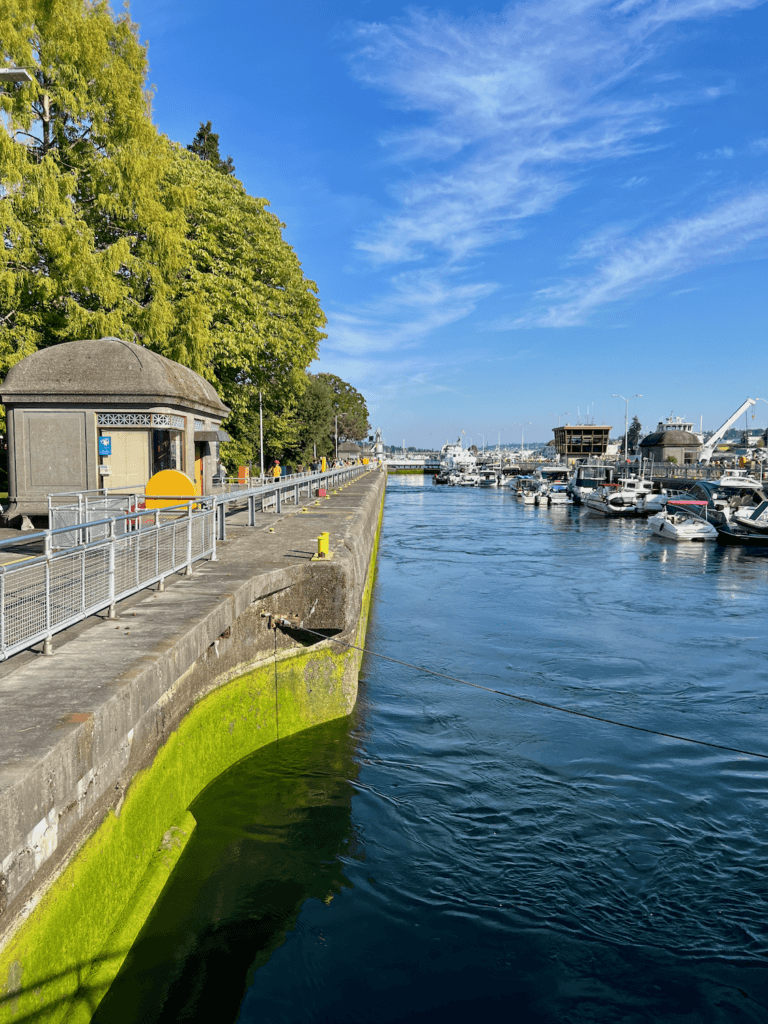

Urban hiking South Park — the one not on TV
I’d never really heard much about South Park until the closure of the West Seattle Bridge required driving a maze of roadways to get between the central part of Seattle and the waterlogged peninsula. I noticed the brightly colored buildings and made it a point to return to wander this part of the Duwamish Waterway that might appear to the untrained eye to be just another industrial zone.
This tiny neighborhood is an area where the Duwamish Tribe is believed to have used summer camps for fishing before contact with European settlers. The Army Corps of Engineers reworked the winding river in the early 20th century to allow an easier path for marine commerce. Slowly, the water bounty dwindled, and the summer fishing camps dispersed.
Today work is underway to reclaim parts of the Duwamish River, and I feel it’s essential for any Seattleite to learn and understand the land we inhabit. An urban hike around South Park is one way to start in this direction. Several anchor restaurants serve fantastic multi-cultural fare. Visit the quirky local coffee shop, Resistencia — to start the experience. Read the placards on display around the historic (and renewed) South Park Bridge and follow Dallas Ave S to get a feel for the former bank of the river. The neighborhood is walkable and charming, with lots of surprises along the way.
Continue this experience by driving 3.4 miles up the road (S Marginal Way) to the Duwamish Longhouse and Cultural Center to learn more about the Duwamish people. Terminal 107 Park, across the street, has some open views of the Duwamish Waterway and reclamation areas with traditional fishing nets.
University of Washington — campus, parks, and nature meditation goodness
The University of Washington is a vibrant area full of the things you’d expect a large international school to hold. My soul feels 20 years old again, and an urban walk is quite interesting in these parts. There are the beautiful grounds of the quad and other areas of the college, the quirky, eclectic mix of shops and restaurants on “the Ave,” and a variety of beautiful parks and nature areas that hold peaceful spaces on the shores of Lake Washington.
There are many options for a cruise through this area of town, including one five-mile version that starts and stops at the Link Light Rail line near Husky Stadium. From this location, head through the Quad area of the University toward the Burke Museum. Eventually, make your way north on University Way NW (The Ave) to Ravenna Park. Trails descend into a valley of thick vegetation that is ideally suited for a fall walk in Seattle.
Once through the park, University Village isn’t too far away, with meticulously-groomed grounds providing fantastic seasonal organic expression — from flower beds to hanging baskets. Take a stroll en route to the serene Union Bay Natural Area, which is stunning when the leaves begin to change colors. Follow the trails along the lake to various nooks with benches that inspire gazing out to watch the waterfowl and boats gliding through the lake.
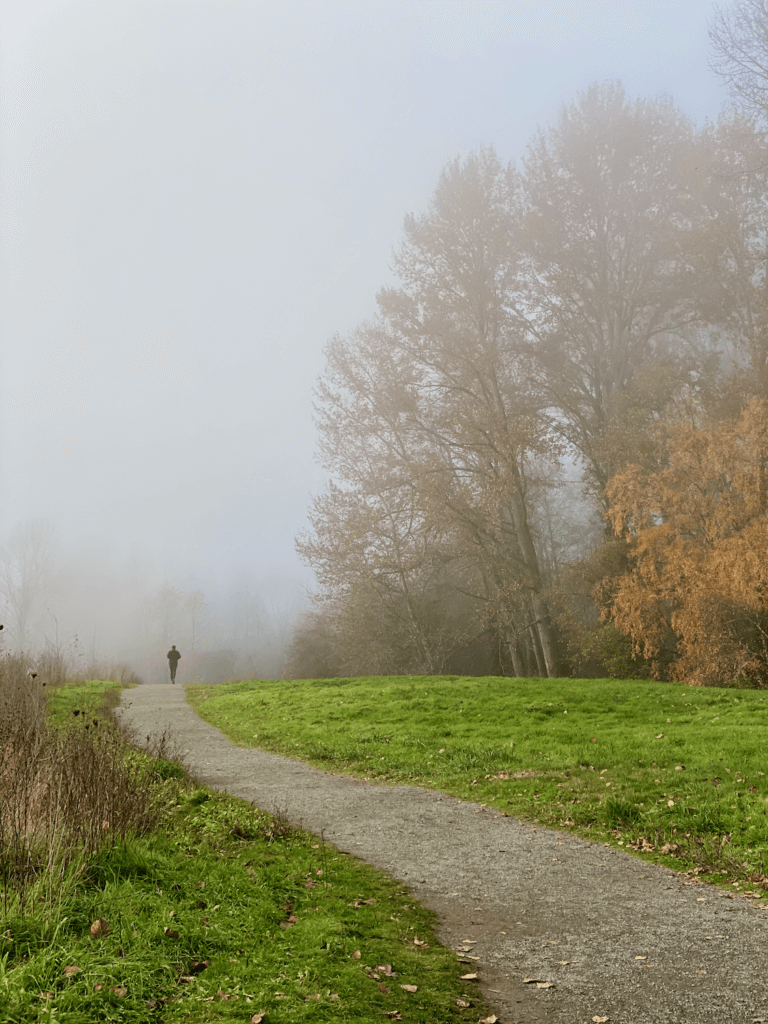

Columbia City — a historic gem of urban hiking in South Seattle
Columbia City is an enclave of South Seattle that oozes with history. A defined main street in the center harkens back to the 1950s when every borough had a movie theatre, drugstore, and meat shop. The local butcher is still in business.
Olympia Coffee is a great place to start the day, maybe before a tasty meal at Geraldine’s Counter (made from scratch comfort food). There is a lot in the several blocks around this intersection (S Ferdinand & Rainier Ave S), from art galleries to bakeries to brewpubs. But the best part is to take a self-guided historical tour by visiting the Rainier Valley Historical Society, where they provide pamphlets for the neighborhood discovery stroll.
A walking street also starts at the circle at 37th Ave S (at Ferdinand), and the Farmer’s Market is on Wednesday’s 3-7 PM (through the middle of October). The best part about Columbia City is that it’s conveniently located on the Link Light Rail line, making it a breeze to get here on a layover at Seatac Airport or from Downtown Seattle.
Add a deeper layer of nature immersion to your visit and walk to and through nearby Seward Park. That’s about 1.5 miles each way (30 minutes), not including whatever length of walk you desire at the beautiful park. If you go, skip the busy outer beach walk and venture into the center of the peninsula where the old-growth cedar and fir hang out.
Urban art and architecture — Outdoor Fall in Seattle things to do
Seattle’s rich art culture is alive in formal museums, architecture, outdoor exhibits, and murals. The events of 2020 brought a new edge to the art expressed in the city — atop plywood window coverings and blank brick walls.
Those taking the Link Light Rail line from Seatac Airport to central parts of the city will enjoy numerous murals only visible from the urban connector — especially between Beacon Hill and Stadium stops. The following are my favorite places to experience Seattle’s outdoor art and architecture.
Fall in Seattle outdoor things to do — explore the art of Seattle University
Seattle University sits quietly tucked amid a whirlwind of activity — wedged between Capitol Hill and First Hill in the city’s heart. I love to stroll through the well-maintained campus grounds enjoying the art which seems to pop out from all directions.
The campus chapel won design awards when it was built in the 1990s, and there is even a modest Japanese tea garden tucked among school buildings. Don’t forget to try out the labyrinth recently installed as a piece to encourage inner peace. Since this is near my neighborhood, I stroll by here a lot and wrote an article titled, The most inspiring art of Seattle University.
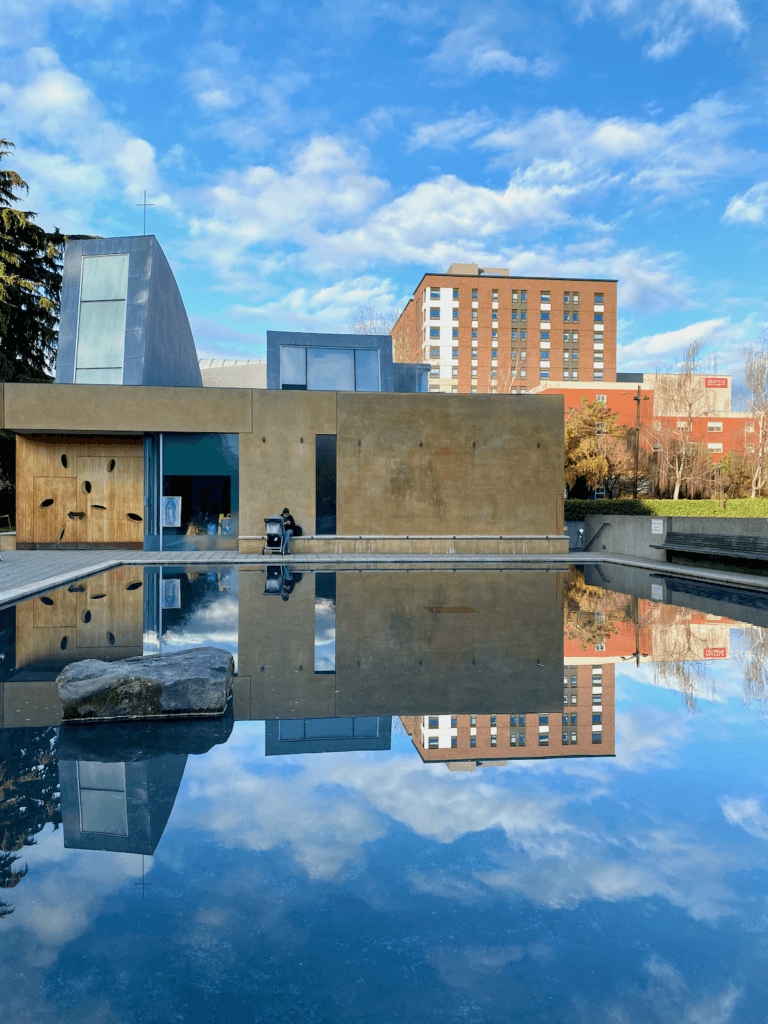
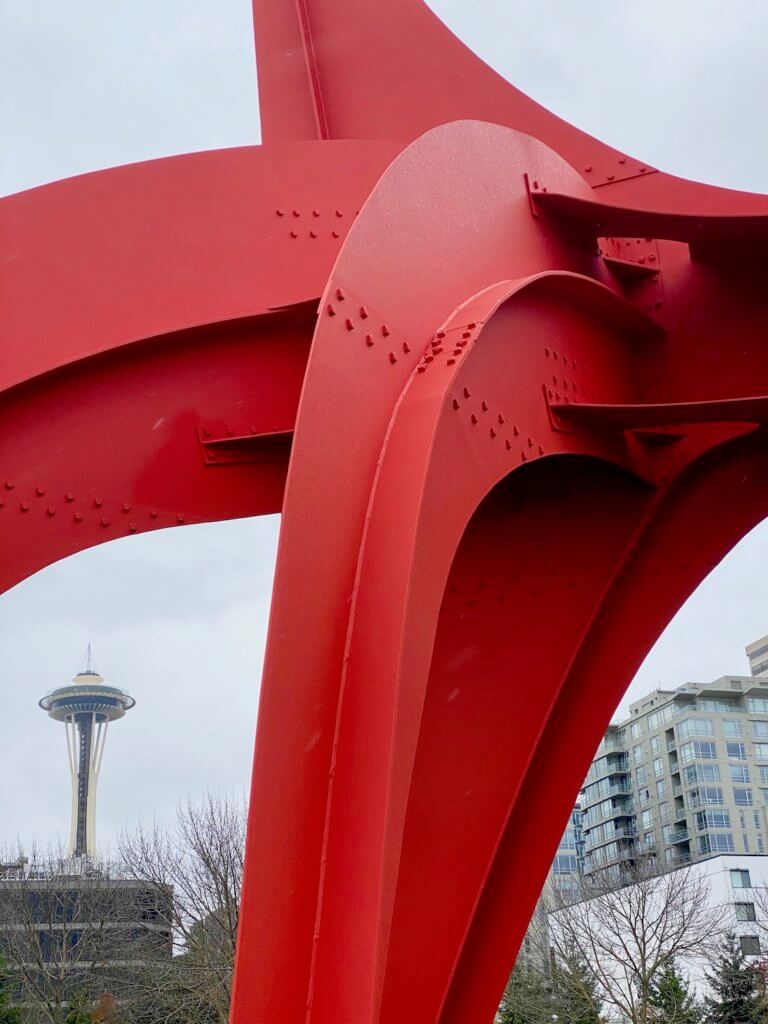
Olympic Sculpture Park
The setting of this patch of thought-provoking exhibits could hardly be matched on a clear day. This front-row view of the Salish Sea is soulful in any weather, but on a clear fall day when the Olympic Mountains emerge in all their grandeur, it’s hard not to feel the delicate balance between the city and nature.
The diagonal pathways meander through casts of metal and grasses planted strategically, bringing to life the feeling of wandering through the dunes at the beach. All the while, the Space Needle hovers above this scene.
Take the pedestrian walkway over the railroad tracks from the nine-acre park to meet up with the Elliott Bay Trail — which brings you north along with the sound as far as you fancy (also mentioned below).
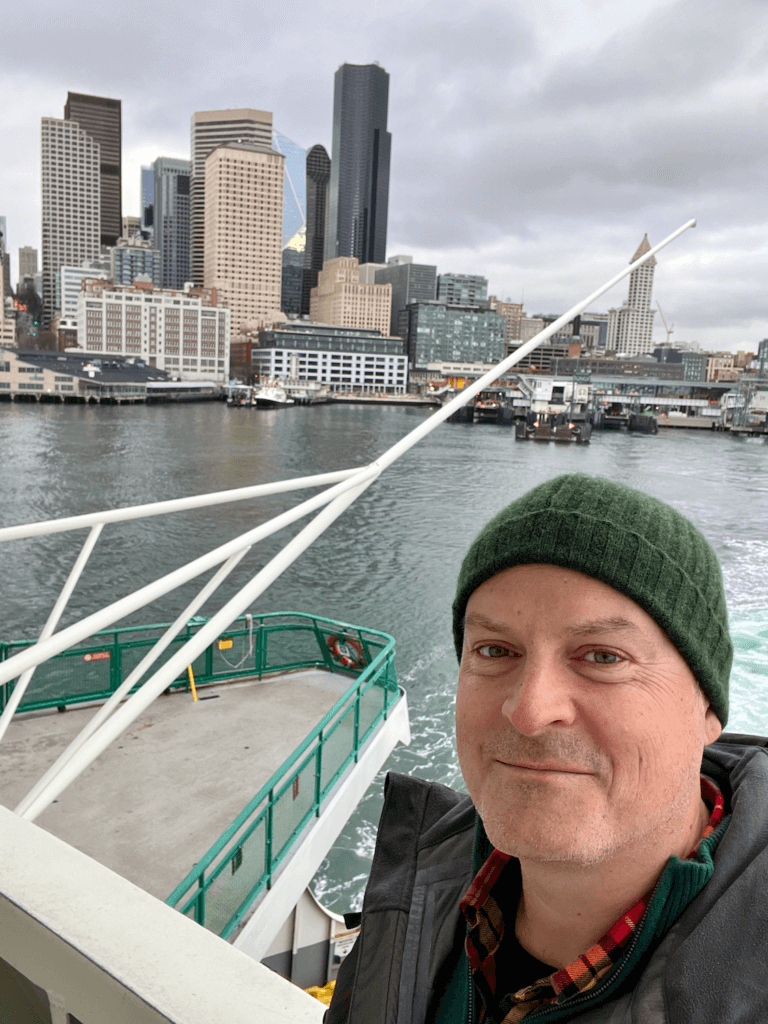
Wander the revitalized waterfront.
Big changes are taking place on Seattle’s waterfront. The oppressive viaduct was removed a few years back, clearing the way for an expanded esplanade heading up the hill to Pike Place Market. Take in the smells of a salty port, and drop into a shop or enjoy seafood with a view.
International Fountain and Art of Seattle Center
The Seattle Center was initially created to house the 1962 World’s Fair — firmly launching the iconic Space Needle into the city’s identity. A cluster of futuristic pavilions was constructed for the event that showcased all the space-age technology that would build the world’s future.
Most of the original buildings were dismantled, but a few remain, such as the mid-century gem that houses the Pacific Science Center. Although recently renovated, Climate Pledge Arena’s roofline remains intact, resembling a ceremonial hat worn by traditional Coast Salish tribes. I enjoy strolling through this collection of architecture because artwork emerges from every direction. Look for the giant daisies extended up toward the Space Needle or the effervescent curvature of the Museum of Pop Culture’s metal exoskeleton.
Continue wandering through the collection of buildings to the giant round ball wedged in the bottom of a sloped concrete basin — like a pinball waiting to drop through a hole. The International Fountain (photo shown) was built for the World’s Fair to showcase space exploration. Recently restored, the massive spray of water shooting from various conduits around this giant ball inspires a child-like urge to run through the streams of mist and spray — even if another spray is coming from above. An activity perfect for a brooding fall in Seattle day.
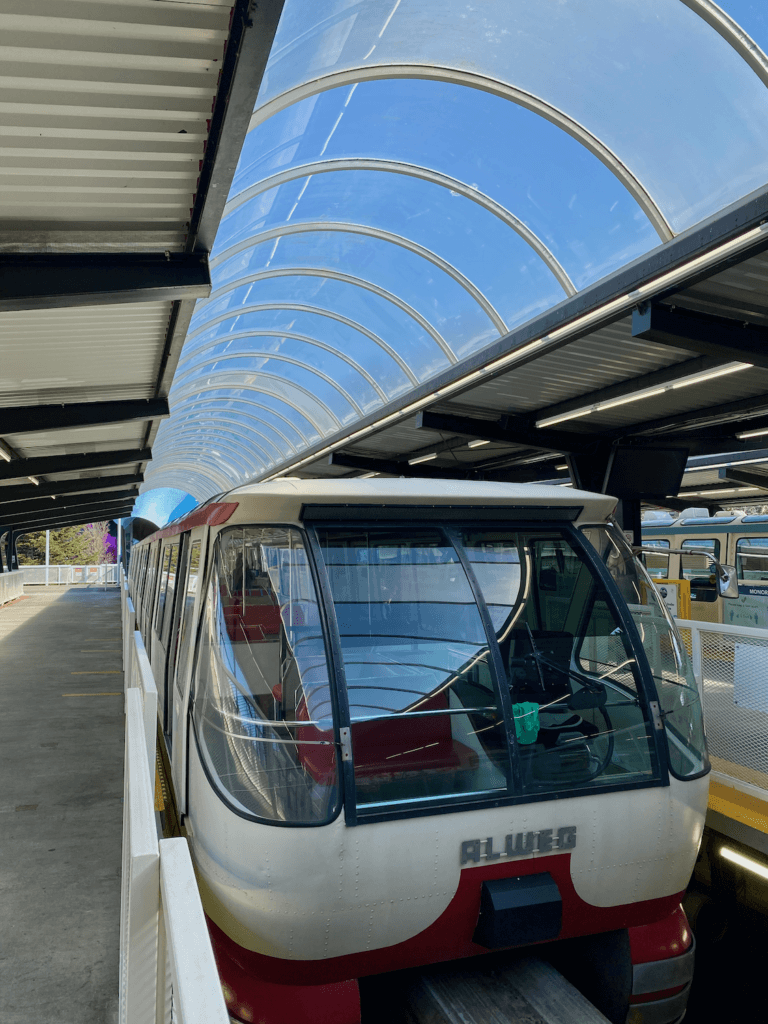
Take the Monorail.
The Seattle Monorail is also a throwback to the World’s Fair. Later, the city proposed creating a network of transportation using this Japanese technology–that never rolled into use. Yet, the line between Seattle Center and Downtown survived. It is not only useful, but a fun way to experience the city. I take all my out-of-town guests on a ride when we’re about town.
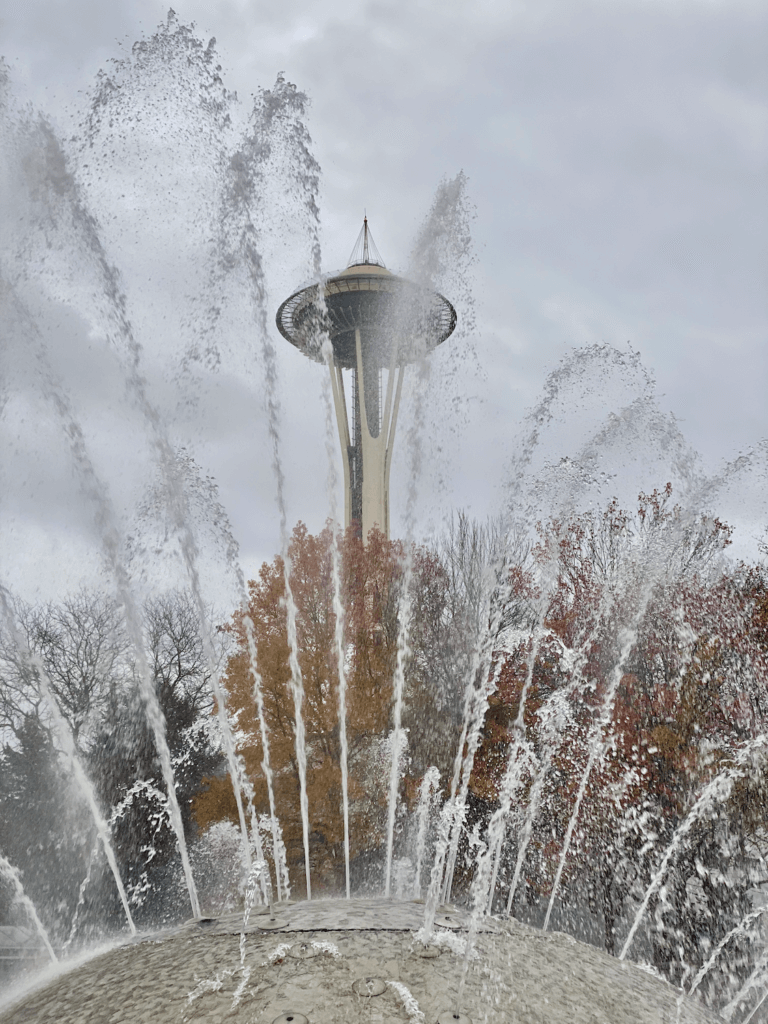
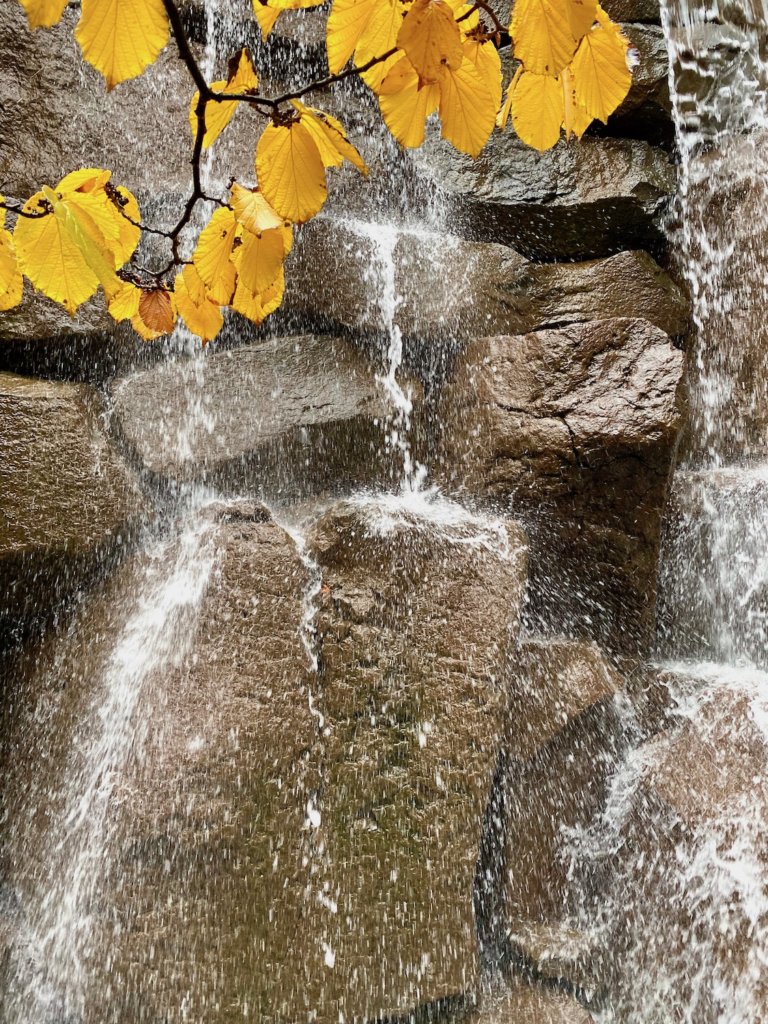
Chinatown and UPS Waterfall Park — great Fall in Seattle outdoor thing to do
Chinatown is a fun place to visit. Some of the best Asian cuisines live in this historic neighborhood, along with colorful dragon gates and other art. Occidental Square offers exciting sculptures, and it’s hard not to be inspired by the beautifully flowing UPS Waterfall Park.
Grab a bite to go from Honey Court Seafood Restaurant or any of the great Chinese restaurants in the area, and have a seat below the metal pergolas that frame the rock wall that, at the time, was the most expensive US park to build per square foot.
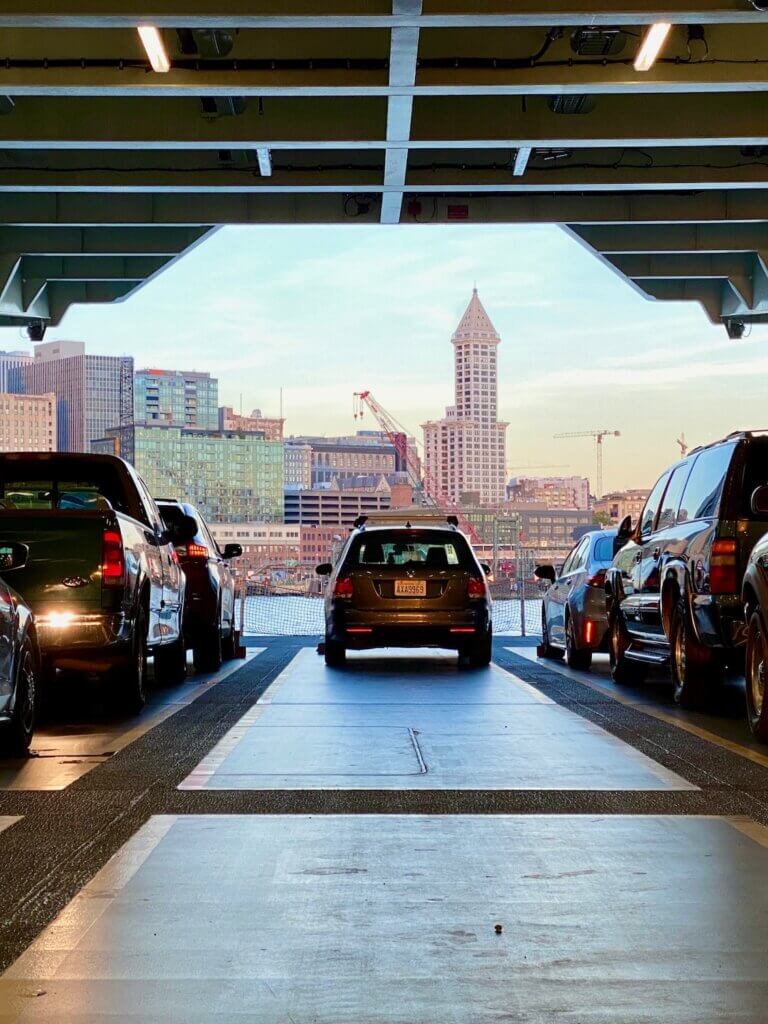
A speakeasy museum with a view?
Smith Tower, located near Pioneer Square in the Old Town of Seattle, was once the highest building West of the Mississippi River. It has a colorful history–associated with prohibition shenanigans and more. As I write in an article about Rooftop Bars in Seattle, this makes a great place to enjoy the skyline–especially when the fall colors abound.
Amazon Spheres and “Tron City”
Seattle’s downtown seems to be morphing every day. Skyscrapers continue to shoot up, sleek steel and glass monuments to the ongoing prosperity of tech giants in the area, most notably Amazon.com. While the glass orbs known as the Amazon Spheres enjoy most of the notoriety, I love wandering through “Tron City,” as I call it.
Just look up, in every direction, at a new city-forming. There are a few Amazon grab-and-go stores that require no exchange of money. Download the app, load a credit card, scan the code to enter, and take whatever you want off the shelves. Perhaps buy a picnic lunch to enjoy at one of the brightly painted red metal benches nearby. Mbar, which I featured in the article about the best rooftop bars to view the Seattle skyline, serves sophistication with a Birdseye view of all that’s new on the tech horizon of the Emerald City.
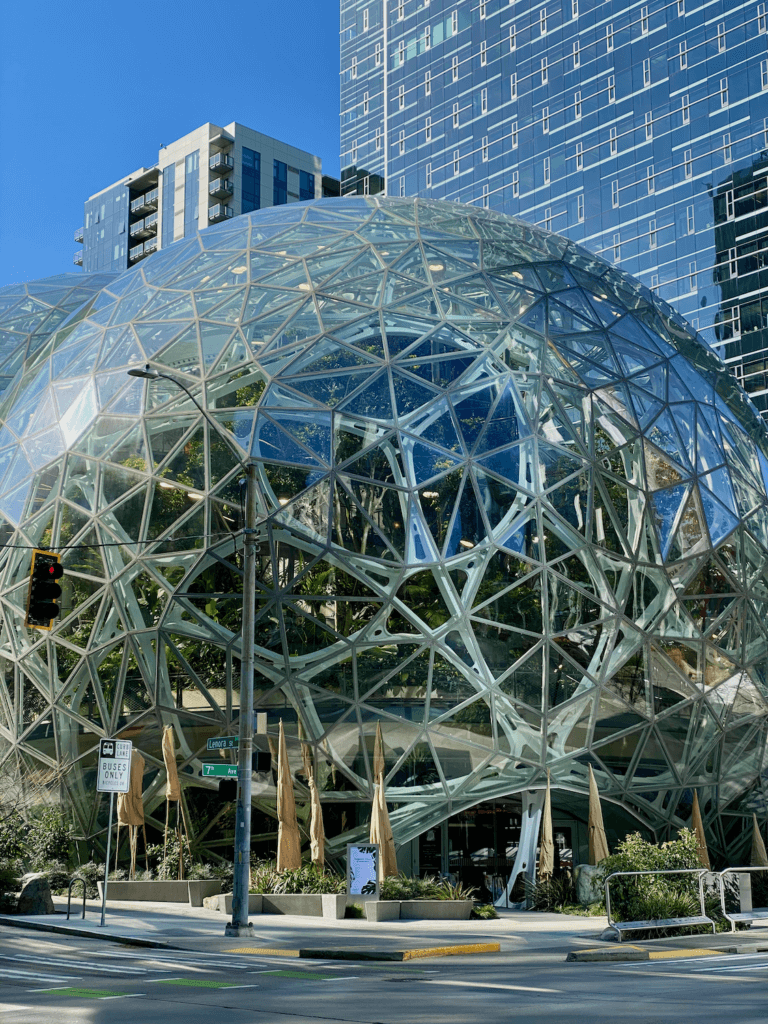
Seattle waters nourish the soul — an exquisite nature meditation any time of year.
Water is ample in every direction around Seattle, any time of year. That’s what keeps our world green, especially fueling the energetic layers of fall texture. While there are plenty of great places to access the water, those listed below are my absolute favorites for the season. I’ve also placed a few additional options on the interactive map below.
Be sure to take an extra layer because microclimates along the water can differ from other parts of the city. When considering a saunter along the Salish Sea (Alki Beach mentioned below), research the tides, as they can change as much as 14 feet between low and high marks. Otherwise, the lake levels stay pretty constant.
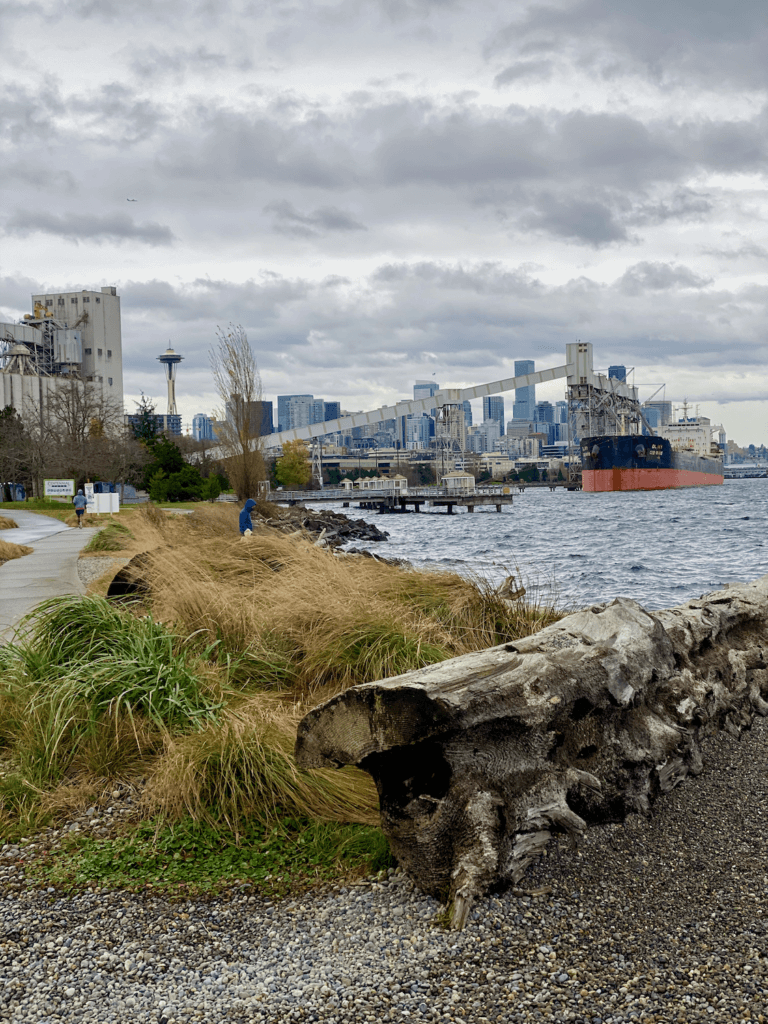
Elliott Bay Trail — outdoor Fall in Seattle sea breeze mindfulness
Reclaimed from heavy industry in the 1980s, this inspiring series of bike and pedestrian pathways connects visitors with the best elements of Seattle. Work continues to update the shoreline that shares space with the deep dark green water of the Salish Sea — new beaches are being formed to help support more natural habitats for salmon and other water life.
Start at the Olympic Sculpture Park (mentioned above) near Pier 70 and continue for about 1.5 miles to Elliott Bay Park (photo above). Even if the breathtaking views of the Olympic Mountains aren’t available, the urban mix of industry, ships, and famous skyline icons offer an interesting juxtaposition with Seattle’s connection to nature. Take a substantial jacket because there is no protection from the elements on this three-mile outing — especially if exploring around sunset.
West Seattle & Alki Beach — King County Water Taxi
I love Alki Beach (Al–Kai) and West Seattle so much that I wrote about this fantastic waterlogged peninsula in another article: The best things to do in West Seattle, including Alki Beach. This stretch of beach and boardwalk is full of life and exciting things to see.
It’s a flat and ridiculously scenic 2 miles and 40 minutes walking to all the hustle and bustle of Alki Beach. (Scooters and bikes are also usually available to rent.) By that time, you’ll be ready for food and beverages by the beach — and there are plenty of solid options. The lighthouse at the end of the spit is walkable along the shore at low tide, but check the tides to avoid getting stranded.
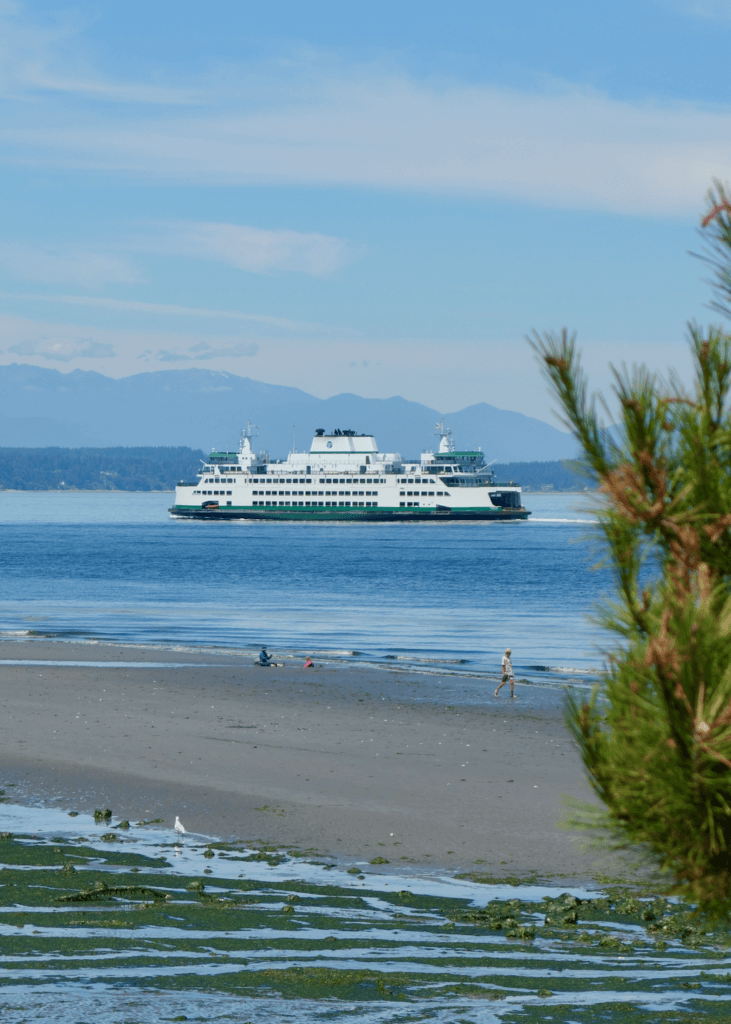
King County Water Taxi
If you’re beginning in central areas of Seattle, a great way to avoid driving is to try the King County Water Taxi, which departs from the brand new Pier 50 Terminal in Downtown Seattle and drops you off at Seacrest Dock near yummy Marination Ma Kai on Harbor Drive.
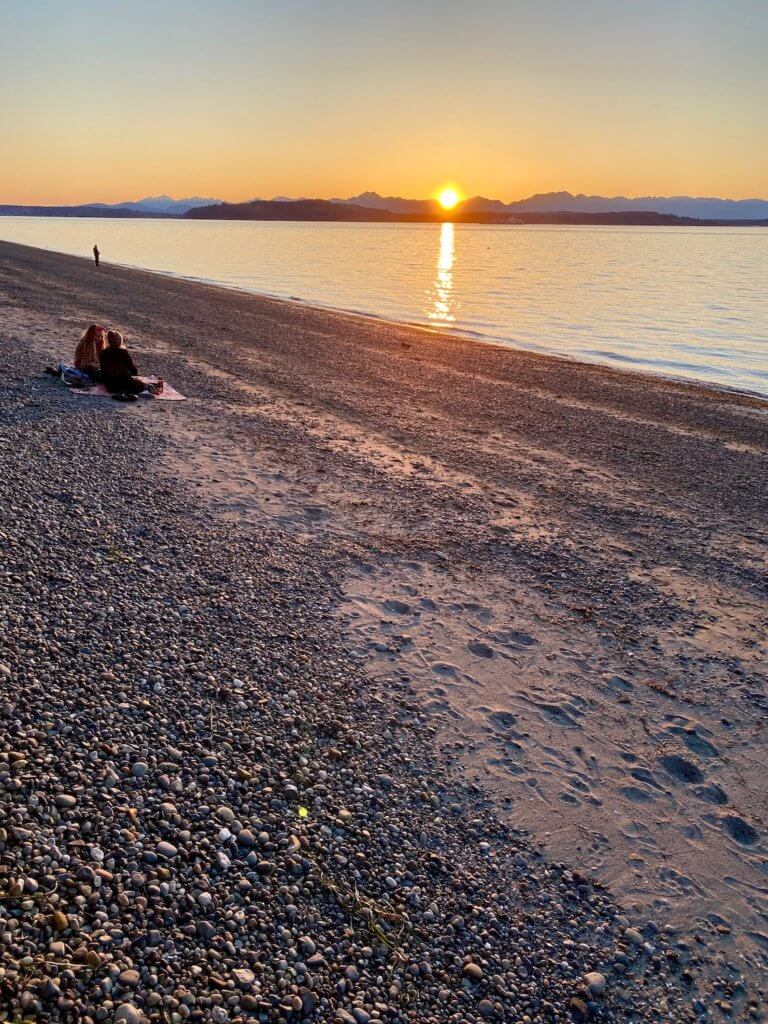

Ballard Locks — the interchange of saltwater and freshwater Seattle
The Ballard Locks inspire visitors with the mechanical marvel of giant gates providing the boundary where the freshwater from city lakes reaches the salty goodness of the Salish Sea. The grounds are free to enter, and paid parking is available.
Follow signs to the main attraction and walk on narrow passages over the giant steel doors that tirelessly hold back tons of water, juggling up and down all day long. Continue toward the other side of the channel to the salmon ladder, where you might find some late-season King or Coho working up the energy to jump up another wrung on the ladder.
Most people seem to beeline to the action of the locks, but I also enjoy a peaceful stroll around the gently looping Carl S. English Botanical Garden. There are many rare plants and trees in this green space, so be sure to pick up a map of the species — near the Army Corps of Engineers visitor center.
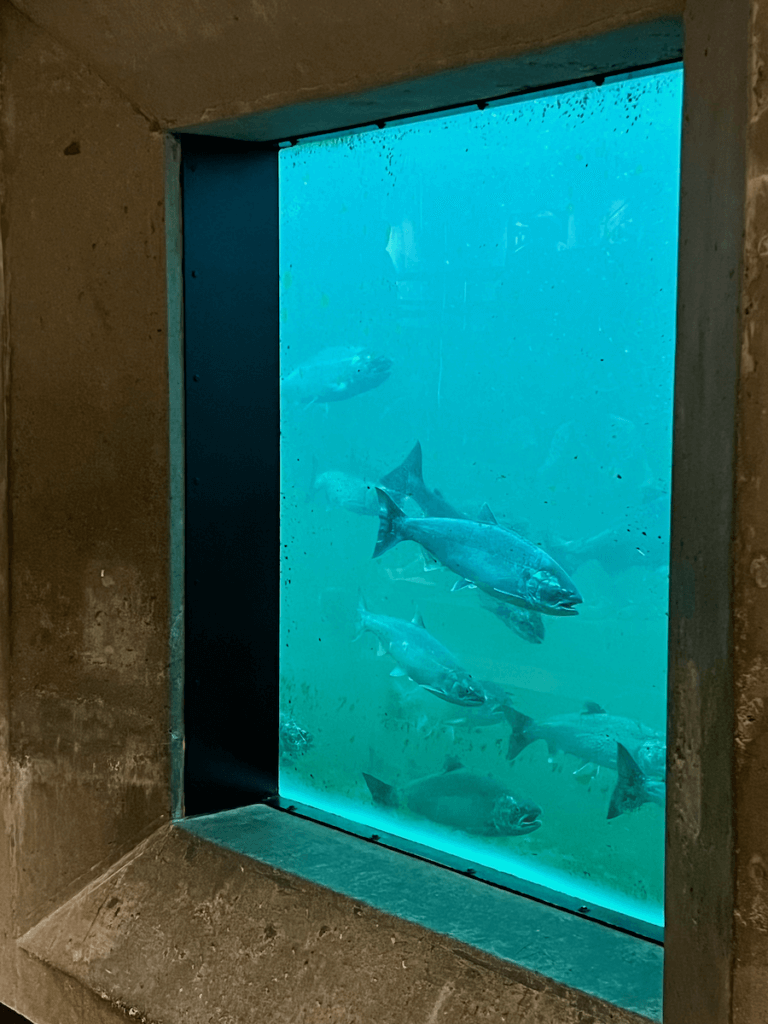
See the salmon jump?
By the thousands, three species of salmon journey through the Ballard Locks each year. It begins with Sockeye in June and ends with Coho in September. The best viewing is above or below (photo shown) the fish ladder. The parking on the south side of the locks (the Discovery Park side) is closest to this experience.
Fisherman’s Terminal — Interbay
Seattle hosts an armada of fishing vessels that work hard to bring the catch from Pacific Northwest waters up to the Aleutian Islands in Alaska. A good portion of the Alaska fleet is based around the docks of Ballard, Fremont, and the fishery industry Mecca, Fisherman’s Terminal.
Chow down on excellent fresh fish-n-chips at Chinooks at Salmon Bay before wandering around the public docks. Watch crew members mending fishing nets, painting boats, refueling, and doing everything necessary to prepare for the next bounty. This beehive of activity is only about 2 miles from the Ballard Locks (mentioned directly above).

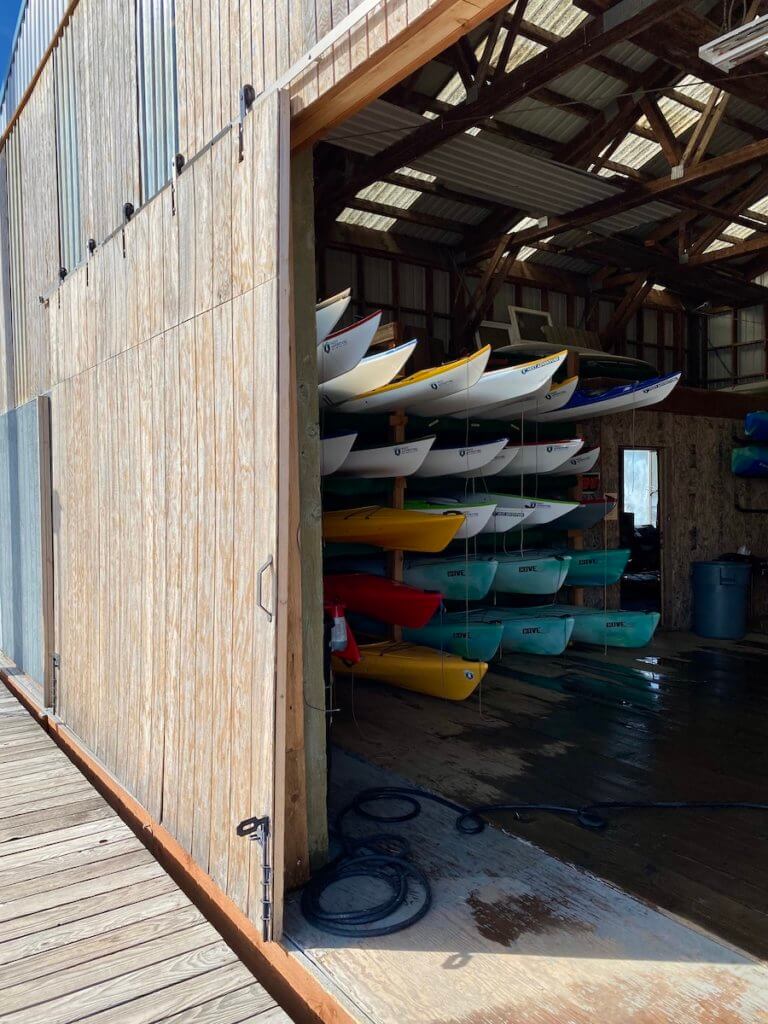
Take a float — nature boating options for Fall in Seattle
It makes sense that a city known for water in every direction would offer some soulful options to boat in the area. Lake Union is central to this recreation. Rent a tiki boat for a spin, or even floating hot tubs. But it’s more likely you’ll connect with the scene a little more deeply by using a canoe or kayak and exploring the area around Union Bay.
In particular, I love the marshy coves that extend north from the Washington Park arboretum. For this, it’s closest to rent canoes or kayaks from UW Waterfront Activities Center.
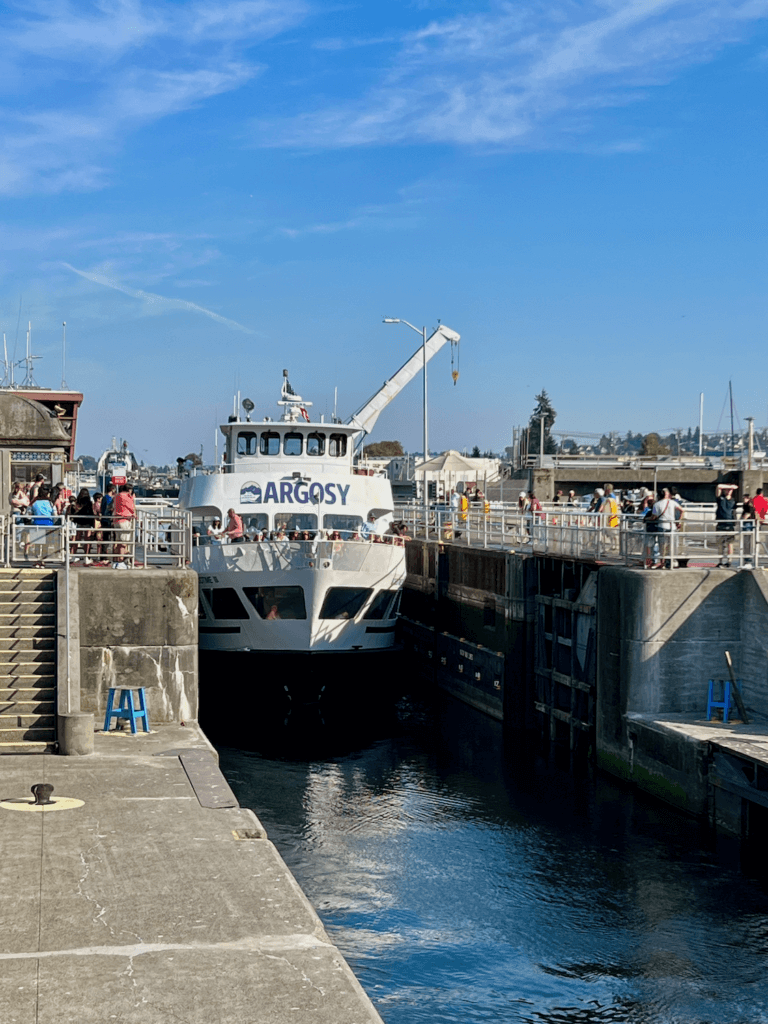
Argosy Cruise between the fresh and salt.
This sight-seeing line does a great job bringing information about the Seattle area–especially by water– to life. A particularly interesting experience is the tour of Ballard Locks cruise. This is a one-way version that (at the time of this writing Fall 2024) costs $54 per adult or $69 with transportation provided back to the starting point.
Leaf peeping adventures — Fall in Seattle short day trips.
The Pacific Northwest offers its distinct brand of colorful wonderland in the fall. And while the urban hiking options I list above are lovely for the core of Seattle (I’m partial to my neighborhood of Capitol Hill for colorful leaves in the area), sometimes wandering outside the city can yield just the right inspiration for the soul. The following ideas are a few of my favorites that aren’t too far away.
Federal Way parks and gardens
Federal Way is a suburb wedged between Seattle and Tacoma — about 30 minutes to either. The area here is full of deciduous trees making their fall transformation. Take a drive to Dash Point or Saltwater State Park (just beyond city limits) to stroll on forest paths that meet the flowing tides of the Salish Sea. Both State Parks require a $10 parking pass or the Annual Discover Pass ($30 for the year).
Beyond the parks, I love PowellsWood Garden for its forest of vivid colors, made up of grand maples, birches, and aspens in a canyon trail that offers tranquility.
Finally, the Rhododendron Species Botanical Garden and Pacific Bonsai Museum are tucked under a grand canopy of maple and fir, adding spice to an enchanting experience.
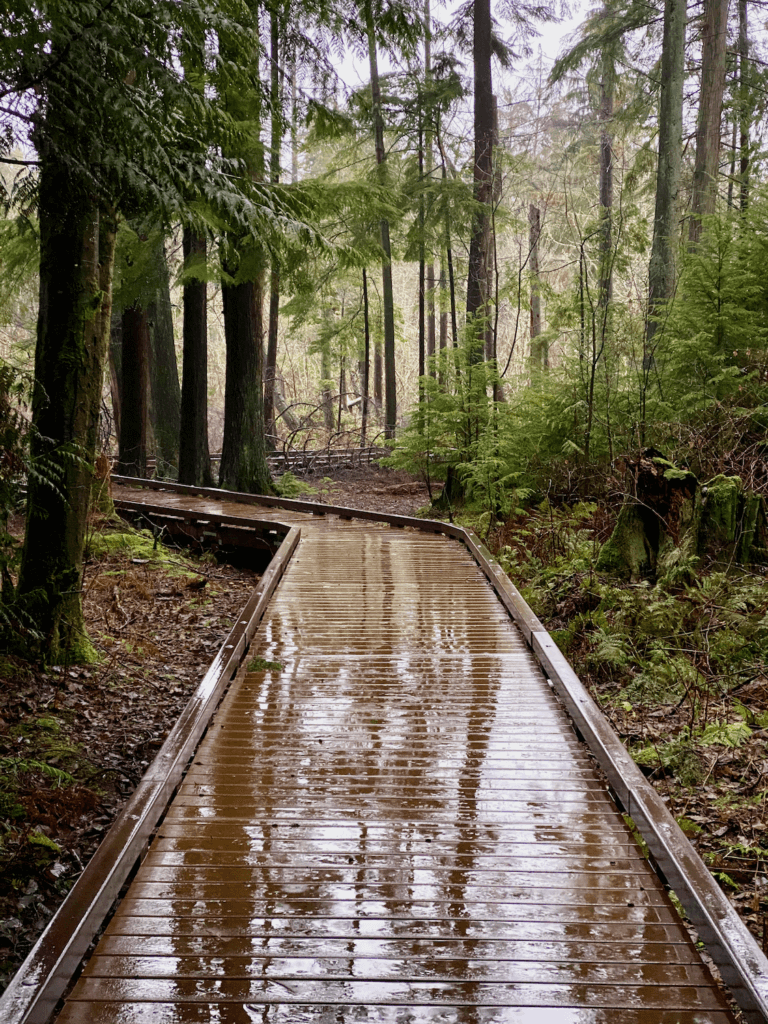
This understated city park in Federal Way, WA has a boardwalk that feels like you’ve entered a portal to another world — complete with cedar, maple, ancient sinkholes, and fresh springs. Watch the video below:

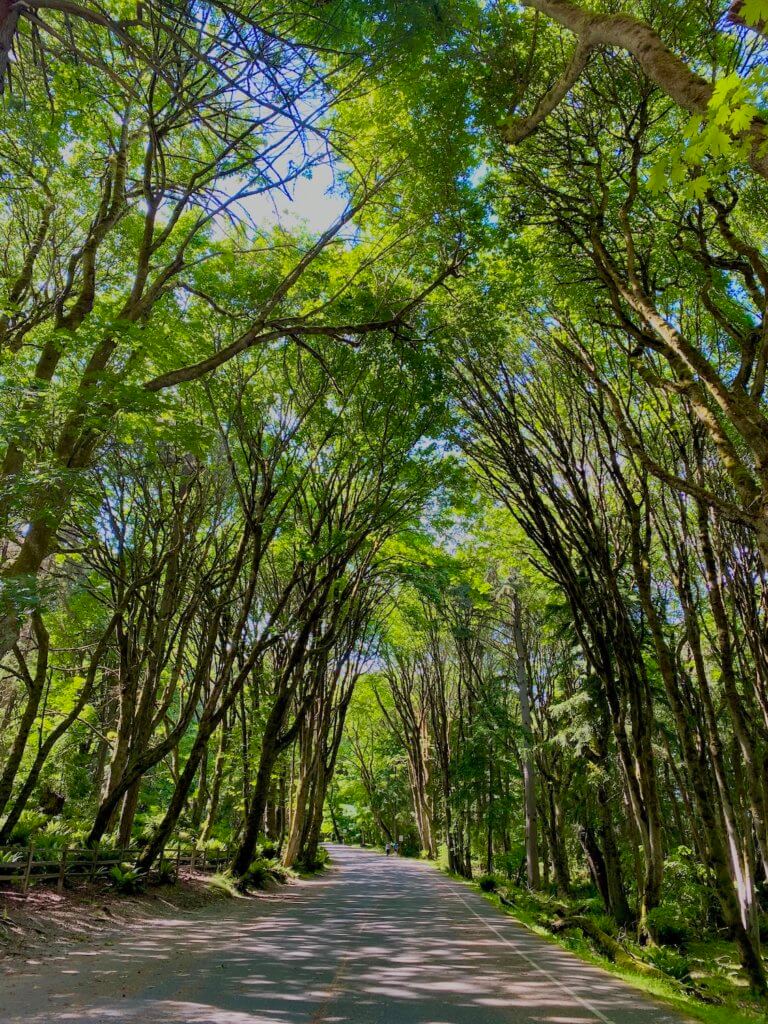
Point Defiance Park — Tacoma’s urban forest
My mom grew up on the edge of Point Defiance Park, so I’ve visited this wonderland of nature throughout the seasons of my life. This 760-acre urban forest inspired me to write a separate article with all the information, Point Defiance Park — Tacoma’s urban wilderness. This place has something for everyone, and if you’ve not explored Tacoma in general, you’re missing out — check out the Proctor and Stadium Districts for starters.
The showstopper in the fall season is Five Mile Drive, with breathtaking canopies of ancient maples that seem to hover over the roadway. While most of the drive closed due to unstable cliffs, you can still bike or hike various distances from accessible parking areas. I love the colors of the canopy above the Rhododendron Garden (photo shown), which is an easy hike from the zoo parking lot.
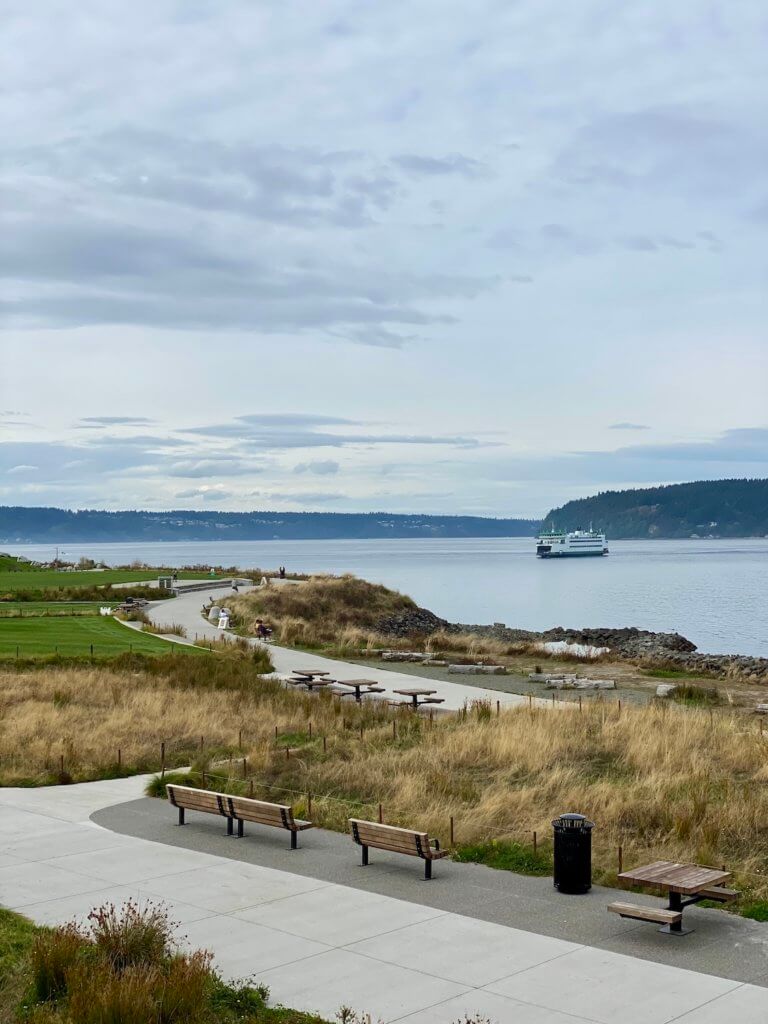
Dune Peninsula at the Park.
My Irish-immigrant relatives were drawn to Tacoma to work in a smelter, situated on the water near Point Defiance Park. Today, the signs of heavy industry have slipped away except for a reclaimed peninsula of land with views of Mt. Rainier and the Vashon Island Ferry. The new park offers a nod to the local Tacoma writer Frank Herbert, who created the seminole novel Dune.
Bainbridge Island and Kitsap Peninsula
The ideal day trip for new visitors to Seattle is a jaunt on the Washington State Ferry to Bainbridge Island. Yes, the cute main street of Winslow is convenient, tasty, and fun, but it doesn’t really deliver the wow of fall colors. I’ve put together an excellent road trip that includes several different things to do, such as the Suquamish Museum and Heronswood Garden (also mentioned below), with all the details: Salish Sea day trip — Bainbridge Island and the Kitsap Peninsula.
This itinerary is an excellent choice to engage the spiritual side of nature while surrounded by stunning fall leaves — including the magical Grand Forest West. This 121-acre park is an excellent destination because the trails are easy and offer exciting views of both mossy cedar and deciduous gold.

Mindfulness meditation under the bright leaves?
A crowd pleaser when I show visitors Bainbridge Island is the Hall’s Hill Lookout and Labyrinth. Plan some time to take it slow and walk the twist and turns with awareness of your inner self. See if you can slow down enough to meander your way both in and out. Watch the video:
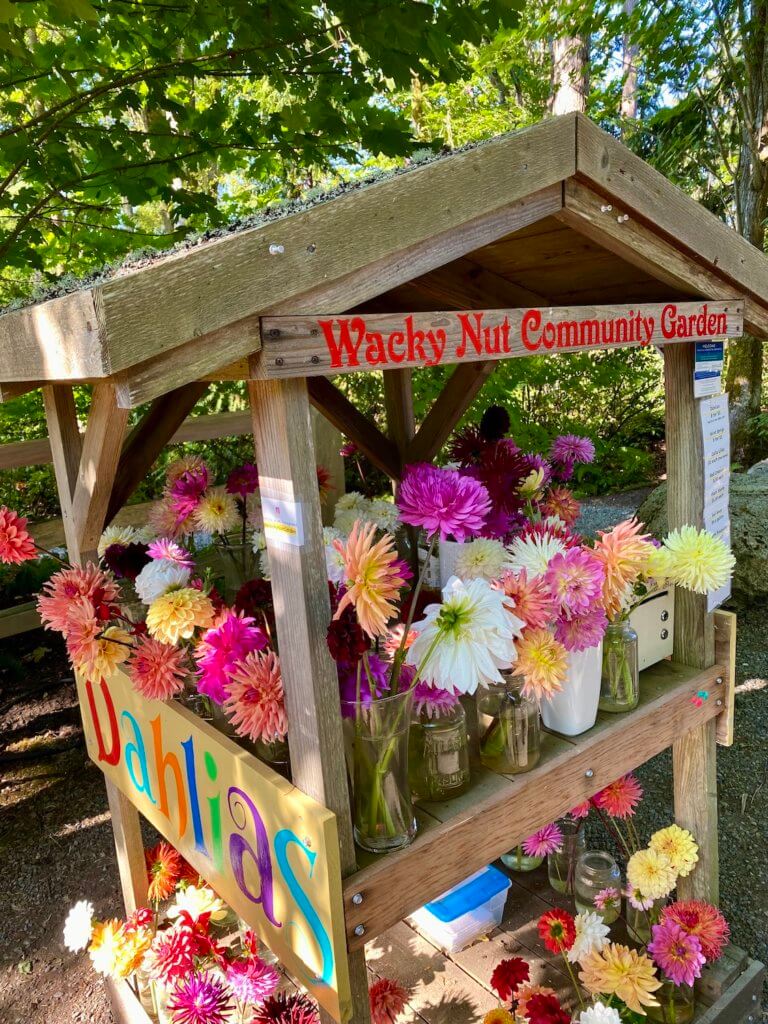
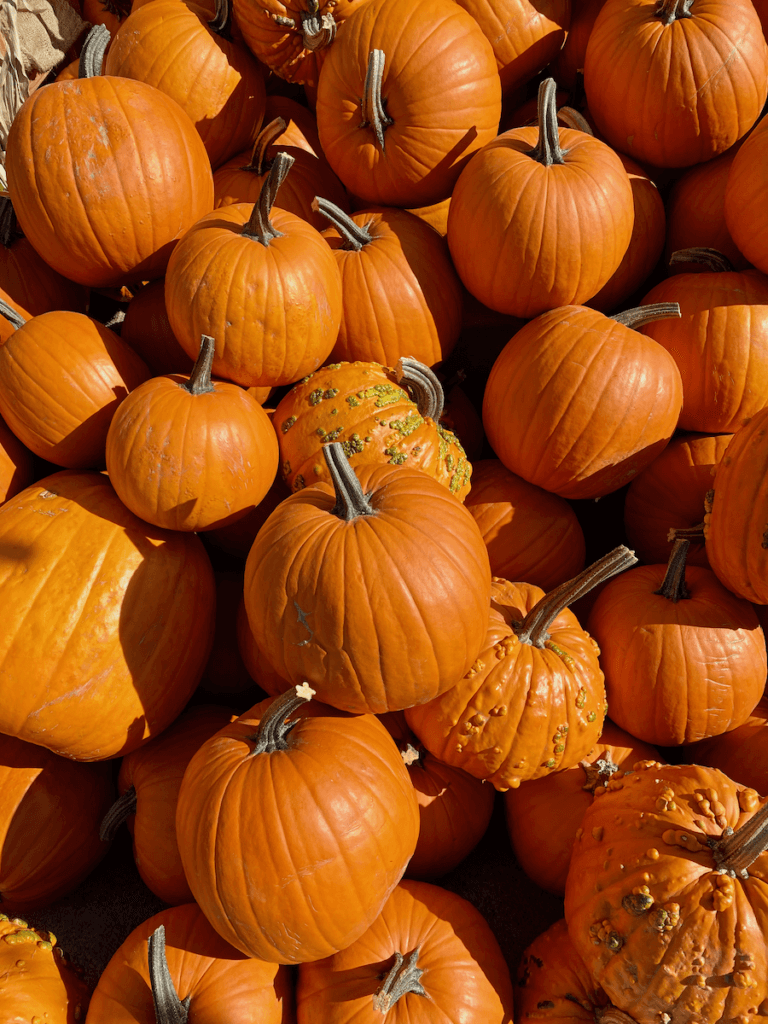
Skagit Valley harvest season
There are other places for harvest season fun, like farms around Aurora and beyond Woodinville. I’m just partial to the Skagit Valley for all the variety of things to do throughout the year. This breadbasket of Western Washington is an hour (plus) drive from Seattle and offers a little bit of something for everyone.
Try Gordon Skagit Farms and crunch on a fresh apple, or launch a pumpkin at Burlington Harvest Festival and Pumpkin pitch (last weekend in September). Christianson’s Nursery, a perennial gem, serves up a great fall vibe, and many more “harvest loop” inspirations can be found on the Skagit Valley Website. If you’re interested in a fun place to stay for a few days to enjoy the scene, look at the information in my article about La Conner.
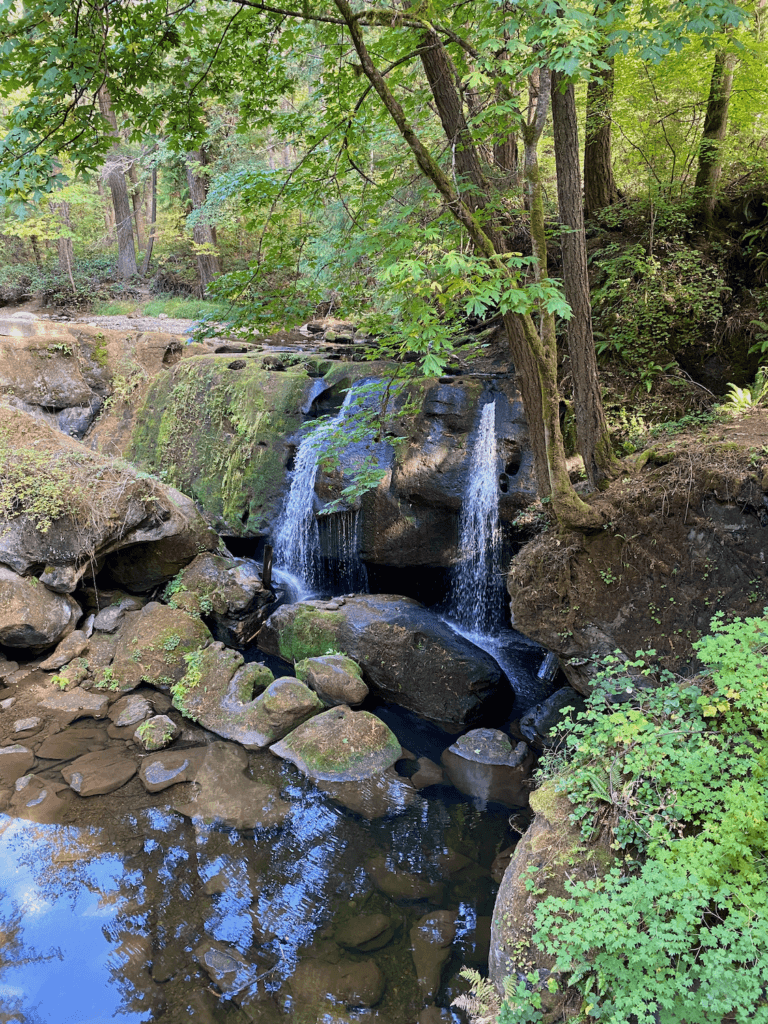
Enjoy fall splendor on the drive to Vancouver, BC.
The Skagit Valley and the neighboring Salish Sea are well discussed in my comprehensive guide to driving between Seattle and Vancouver, Canada. The article includes a beneficial interactive map with my favorite places to stop along the way — including Whatcom Falls (photo shown). If you want a “wow” drive for leaf-peeping consider the marvelous Chuckanut Drive–between Bow, WA and Fairhaven, Bellingham, WA.
Billy Frank Jr. Nisqually National Wildlife Refuge
This serene valley of land just adjacent to the Salish Sea is often overlooked as travelers rush between Portland and Seattle on busy I-5. Yet, the forests that line the Nisqually River offer excellent fall color that ushers you toward an impressive boardwalk.
Continue for two miles to a gazebo that straddles either mounds of seaweed, turf, and sand or seawater’s salty goodness, depending on the tides. It costs $2 cash to park in the lot adjacent to exit #114 on I-5. If you’re interested in more details, try my article. For more watch my video below:
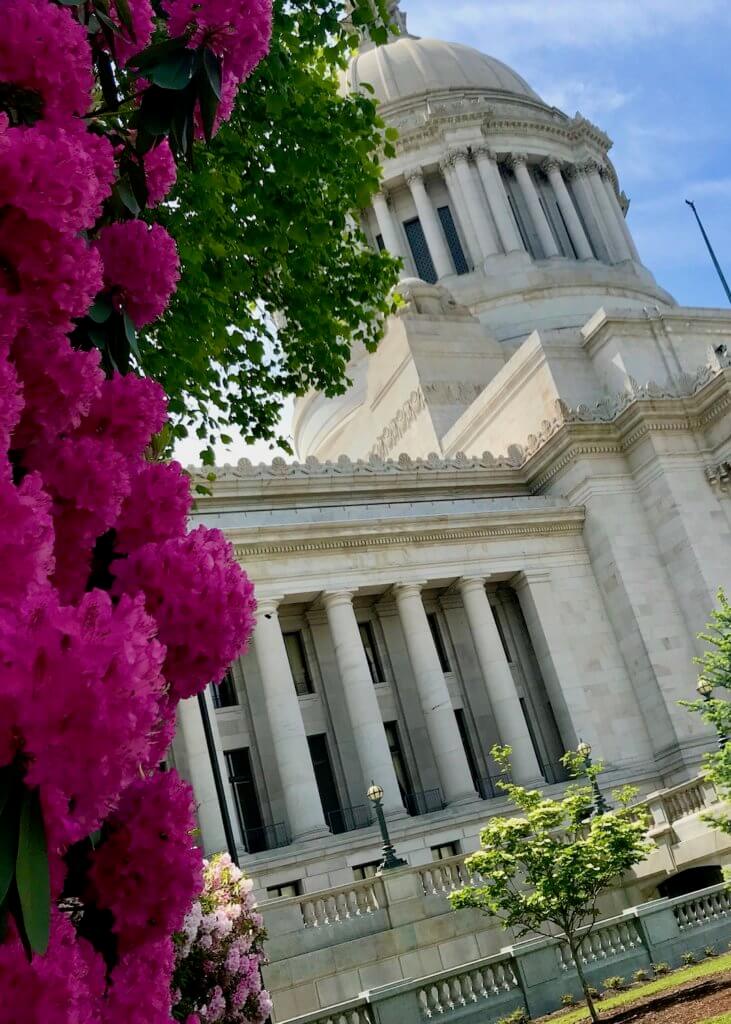
Check out Olympia?
While you’re there… why not explore Olympia, the capitol of Washington State? Take in the rushing water of Tumwater Walls, and visit the well-manicured grounds around a commanding dome building. Plus, the crunchy downtown business core serves up some fun food and drink options.

Interactive map — outdoor Fall in Seattle things to do
This map is a collection of my favorite nature connections in Seattle — including some lesser-known Seattle botanical gardens and others around the Salish Sea area. I have been to all these locations and hope you enjoy them as much as I do.
These suggestions are my point of view — I do not receive compensation for placement on the map or written articles unless expressly noted
Break from the status quo.
There’s more to your nature.
Let me help you find it.
